Fantasy Books
Half a Century of Reading Tolkien: Part Five: From the Beginning — The Hobbit by JRR Tolkien
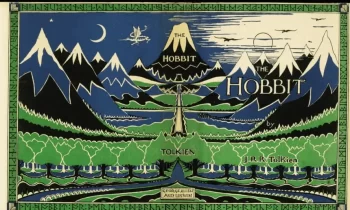 In a hole in the ground there lived a hobbit.
In a hole in the ground there lived a hobbit.
Chapter 1, An Unexpected Party – The Hobbit
Fifty years ago, when I first read this book, I didn’t imagine I’d still be reading it so many years later. Heck, I doubt I could have even imagined being as old as I am now. But I do reread it every few years. When I revisit The Hobbit, my journey is bathed in nostalgia as much as with the simple enjoyment caused by reading a charming book that I happen to know inside out, from the opening line above on through to the very end.
In my initial article on half a century of reading Tolkien back in January, I described my dad trying to get our first color tv in time to watch the Rankin & Bass The Hobbit. Remembering that again last week left me thinking more of my dad, now gone nearly 24 years, than the book. He was ten years younger than I am now when the movie first aired, which makes me feel incredibly old at the moment. For such a conservative man, he was excited to see it — admittedly, in a restrained way. I think we liked it well enough, but leaving out Beorn irked us both. Beyond Tolkien’s books, our fantasy tastes rarely coincided (I’ve got a shelf full of David Eddings books he bought, if anyone’s interested), but with The Hobbit and LOTR, we were in complete agreement.
What’s there to say about The Hobbit here on Black Gate? Nothing, really. I imagine most visitors here have read it, many more than once, and have their own ideas on it. It’s one of the most widely read books in the world. Instead, I’m going to discuss some adaptations of the book. But first, a summary.
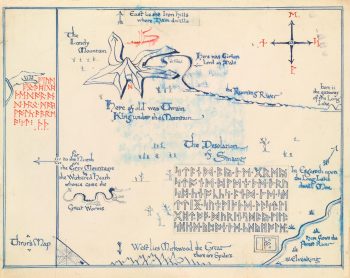 Map of the Lonely Mountain by JRR Tolkien
Map of the Lonely Mountain by JRR Tolkien
Hobbits are Tolkien’s slightly comical take on the staid British country folk. Their homeland is so British in nature, it’s even called the Shire. They prefer comfort and predictability and tend toward stoutness. Bilbo Baggins, the only son of wealthy parents has settled into a very predictable and very comfortable middle-age. When Gandalf, a wizard known fondly for magnificent fireworks and less fondly for occasionally leading young hobbits off on some adventure, appears at his doorstep, Bilbo’s life takes a drastic turn. The wizard has come to bring Bilbo on an adventure. Despite the hobbit’s denial of any interest in such an undertaking, Gandalf leaves a mark on his door so a throng of dwarves can find their way their the next day.
The dwarves, led by Thorin Oakenshield, are survivors of the Lonely Mountain. Once a mighty and wealthy dwarven stronghold, one hundred and seventy one years earlier, it was sacked by the great dragon Smaug and its citizens killed or driven out. Save Thorin and one other, the dwarves are miners and smiths, not fighters. Still, the band is determined to reclaim their mountain and their treasure, despite having neither a plan nor the means to remove the dragon.
Succumbing to a repressed ancestral taste for adventure, Bilbo joins the dwarven company on its quest. Soon, Bilbo finds himself on the wrong side of hungry trolls, angry goblins, and, perhaps worst of all, Gollum.
Deep down here by the dark water lived old Gollum, a small slimy creature. I don’t know where he came from, nor who or what he was. He was Gollum—as dark as darkness, except for two big round pale eyes in his thin face. He had a little boat, and he rowed about quite quietly on the lake; for lake it was, wide and deep and deadly cold. He paddled it with large feet dangling over the side, but never a ripple did he make. Not he. He was looking out of his pale lamp-like eyes for blind fish, which he grabbed with his long fingers as quick as thinking. He liked meat too. Goblin he thought good, when he could get it; but he took care they never found him out. He just throttled them from behind, if they ever came down alone anywhere near the edge of the water, while he was prowling about. They very seldom did, for they had a feeling that something unpleasant was lurking down there, down at the very roots of the mountain. They had come on the lake, when they were tunnelling down long ago, and they found they could go no further; so there their road ended in that direction, and there was no reason to go that way—unless the Great Goblin sent them. Sometimes he took a fancy for fish from the lake, and sometimes neither goblin nor fish came back.
Just prior to his encounter with Gollum, Bilbo finds a plain golden ring, a Ring that will come to prove of vital importance in later years. After discovering it turns its wearer invisible, Bilbo uses it to his advantage to escape from the goblins, and to save the dwarves on several occasions, once from giant spiders and once from elven prison cells. Eventually, he even uses it to allow himself to engage in some dangerous banter with the dragon.
“Well, thief! I smell you and I feel your air. I hear your breath. Come along! Help yourself again, there is plenty and to spare!”
But Bilbo was not quite so unlearned in dragon-lore as all that, and if Smaug hoped to get him to come nearer so easily he was disappointed. “No thank you, O Smaug the Tremendous!” he replied.
“I did not come for presents. I only wished to have a look at you and see if you were truly as great as tales say. I did not believe them.”
“Do you now?” said the dragon somewhat flattered, even though he did not believe a word of it.
“Truly songs and tales fall utterly short of the reality, O Smaug the Chiefest and Greatest of Calamities,” replied Bilbo.
“You have nice manners for a thief and a liar,” said the dragon. “You seem familiar with my name, but I don’t seem to remember smelling you before. Who are you and where do you come from, may I ask?”
“You may indeed! I come from under the hill, and under the hills and over the hills my paths led. And through the air. I am he that walks unseen.”
“So I can well believe,” said Smaug, “but that is hardly your usual name.”
“I am the clue-finder, the web-cutter, the stinging fly. I was chosen for the lucky number.”
“Lovely titles!” sneered the dragon. “But lucky numbers don’t always come off.”
“I am he that buries his friends alive and drowns them and draws them alive again from the water. I came from the end of a bag, but no bag went over me.”
“These don’t sound so creditable,” scoffed Smaug. “I am the friend of bears and the guest of eagles. I am Ringwinner and Luckwearer; and I am Barrel-rider,” went on Bilbo beginning to be pleased with his riddling.
“That’s better!” said Smaug. “But don’t let your imagination run away with you!”
By hands other than their own, the dwarves find themselves rid of the dragon. This leaves them in control of the mountain and the treasure. Part of the treasure, though, is sought, not unreasonably, by the dragon’s slayer, among others. Dwarves, being dwarves — “dwarves are not heroes, but calculating folk with a great idea of the value of money” — have no intention of giving up one farthing of their hoard, and soon the stage is set for a great battle. Bilbo makes it home, but only after having to commit an act of great moral bravery. The hobbit who returns home is not the same as the one who left, which of course, will turn out to be of the greatest importance for Middle-earth in the years to come.
The first and best adaptation I’m familiar with is the audio version performed by Nicol Williamson for Argo Records in 1974. Lasting nearly four hours, it has the room to tell most of the story. I remember my mother bringing it home from the library and realizing how long and complete it was. I listened to all of it on a Saturday and loved every minute of it.
Williamson himself did many of the edits, removing the most of the ‘he saids.’ He used various regional UK accents to differentiate the various characters. Williamson was one of the great stage actors of the last century, possessed of an absolutely magnificent and captivating voice. I haven’t listened to all of Andy Serkis’ unabridged presentation of the book, but as good as what I’ve heard is, Williamson’s is still the winner. Here’s Part Two of Williamson’s version, starting with Bilbo’s encounter with a wonderfully ghastly sounding Gollum.
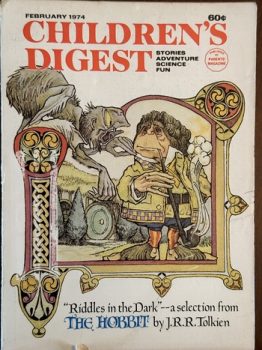 The video clip above of Bilbo and Smaug in the summary is from the second adaptation, the 1977 Rankin and Bass animated The Hobbit. The character designs were by Lester Abrams who had illustrated the Bilbo-Gollum confrontation for Children’s Digest. Arthur Rankin had seent he illustrations and liked them enough to engage Abrams for the movie. The animation was done by the Japanese company Topcraft (which would later go on to do Miyazaki’s first movie, Nausicaä of the Valley of the Wind, and become part of the foundation of Studio Ghibli).
The video clip above of Bilbo and Smaug in the summary is from the second adaptation, the 1977 Rankin and Bass animated The Hobbit. The character designs were by Lester Abrams who had illustrated the Bilbo-Gollum confrontation for Children’s Digest. Arthur Rankin had seent he illustrations and liked them enough to engage Abrams for the movie. The animation was done by the Japanese company Topcraft (which would later go on to do Miyazaki’s first movie, Nausicaä of the Valley of the Wind, and become part of the foundation of Studio Ghibli).
I love the movie, despite its too-rapid pace, the elimination of Beorn, and overall simplification. The painted scenery and backgrounds are wonderful, presenting Middle-earth in warm, muted colors. It looks at once realistic and fantastic. The voice acting, if not of Williamson’s caliber, is first-class, with Orson Bean as Bilbo, John Huston as Gandalf, Hans Conreid as Thorin, and, most wonderfully, Brother Theodore as Gollum.
 Map of Wilderland by JRR Tolkien
Map of Wilderland by JRR Tolkien
It’s far from perfect, but it succeeds better than anything else at conveying a sense of real wonder with each new encounter Bilbo has with the increasingly strange and dangerous denizens of the Wilderlands east of the Shire. Rankin had declared that there would be nothing in the movie that wasn’t in the book, and he proved largely true to his word. It also makes good use of Tolkien’s songs. I admit to not loving Tolkien’s songs and poetry in The Lord of the Rings, but in The Hobbit, he provides some solid children’s poetry and it carries over well in the film. That it remains a children’s film and not some tarted up action movie is its greatest strength. Bilbo is a likeable and brave, and the scary bits are just scary enough for young viewers. At 78 minutes, it’s also the perfect length to get exposed to Middle-earth and JRR Tolkien.
I haven’t much to say about Peter Jackson’s three, interminable, cacophonous movies save “I give up!” I feel like I watched them for penance for any and all sins I’ve ever committed and will yet commit. Martin Freeman is fine enough, if far too thin, as Bilbo, but everything else is awful. Instead of the episodic charm of JRR Tolkien’s actual book, Jackson delivered three movies totaling nearly eight hours of sodden, CGI-infested stuff, packed full of things JRR Tolkien could never have conceived of.
Like with his LOTR trilogy, the films diverge from their sources the further they move along. While the first, An Unexpected Journey (2012), largely follows the form and shape of the book, the second, The Desolation of Smaug (2013), adds an unbelievably poor romantic entanglement and hints of municipal corruption in Lake Town. The dwarves Rube Goldberg plan to encase Smaug in molten gold had me wishing I had more hair to pull out of my head. By the third chapter, The Battle of the Five Armies (2014), all bets are apparently off. Even though I hate Jackson’s desire to turn the the titular battle into a gigantic spectacle, I understand it. The shenanigans of the the Master of Lake Town, however, are awful and nothing anybody who’s at all interested in the fate of Bilbo and the dwarves will be at all interested watching.
Oh, and I haven’t mentioned the terrible-looking and slog that is Gandalf and the White Council’s battle with the Necromancer, aka Sauron. No more than a plot device to extract Gandalf from the story, Jackson turned it into a great, big thing. It was fun to imagine just what happened while reading the book, but on the screen, it’s just one more great big distraction from what should be the only focus — Bilbo and the dwarves. And bird crap-covered Radagast and his bunny-draw sledge is stupid.
The great thing about the Jackson’s movies is that you don’t have to watch them if you want some sort of theatrical presentation of The Hobbit. Just go listen to Williamson (or Serkis, if you prefer) or watch the Rankin and Bass. Both are clearly works of love and respect for JRR Tolkien’s actual book and almost as much fun as reading the book itself.
Next month, I think it’s a time for something special; a visit to the Harvard Lampoon’s tremendously funny and offensive parody (and excellent pastiche) of Lord of the Rings, the Harvard Lampoon’s 1969 Bored of the Rings.
Half a Century of Reading Tolkien: Part One
Half a Century of Reading Tolkien: Part Two – The Fellowship of the Ring by JRR Tolkien
Half a Century of Reading Tolkien: Part Three — The Two Towers by JRR Tolkien
Half a Century of Reading Tolkien: Part Four — The Return of the King by JRR Tolkien
Fletcher Vredenburgh writes a column each first Sunday of the month at Black Gate, mostly about older books he hasn’t read before. He also posts at his own site, Stuff I Like when his muse hits him
You Can’t Handle the Tooth, Part II
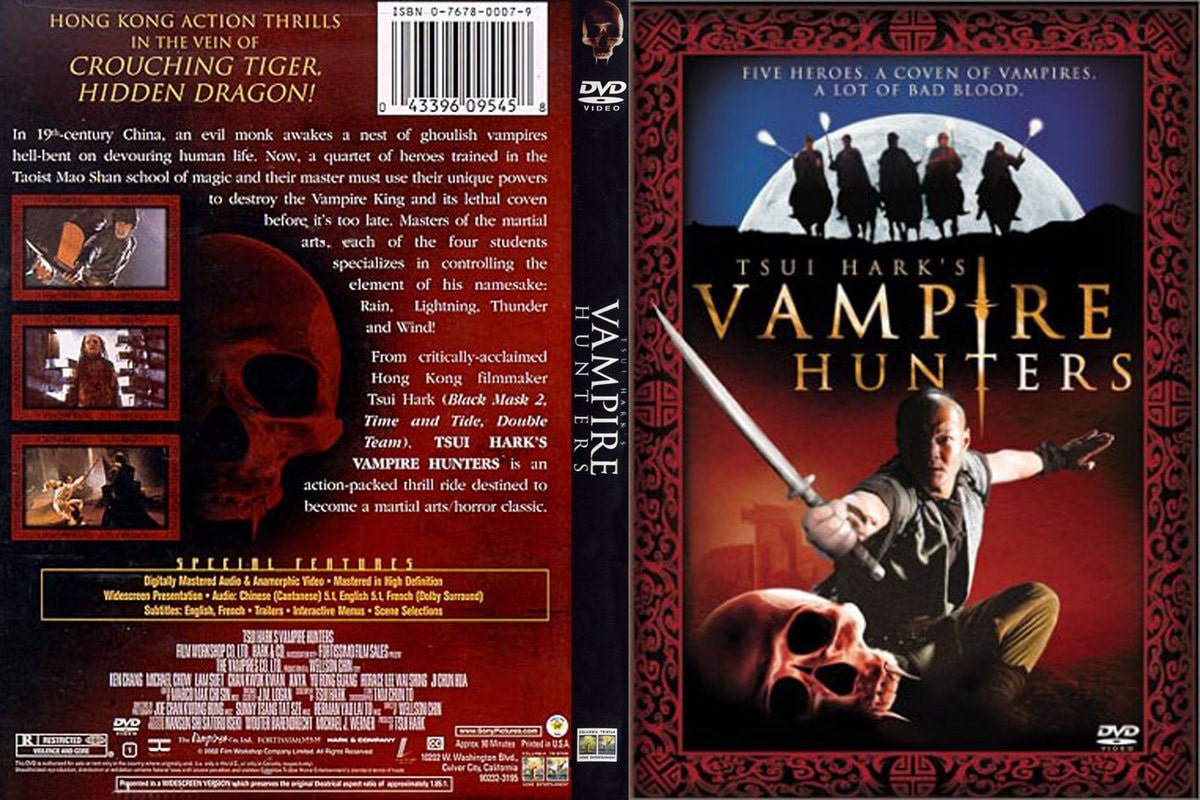 Tsui Hark’s Vampire Hunters (Film Workshop, 2002)
Tsui Hark’s Vampire Hunters (Film Workshop, 2002)
20 vampire films, all first time watches for me.
Come on — sink ’em in.
Tsui Hark’s Vampire Hunters (AKA The Era of Vampires) (2002) – PrimeThe original title is Era of Vampires, but for the North American release we end up with a spectacular bit of bait and switch trickery. Anyone who knows Tsui Hark’s work would be excited, after all, he gave us Zu Warriors from the Magic Mountain and the Once Upon a Time in China series — but we have been fooled. He produced this film, and wrote the story, but the director is Wellson Chin, better known for romantic comedies. For those of you who don’t know what this means, imagine going to see Steven Spielberg’s Jaws: The Legend Returns, and it’s directed by McG.
Anyhoo — the story is a simple one. Four Shaolin monks and their master have trained to locate and defeat vampires, but the first one they find manages to fend off 20 warriors and make the master go missing. The four (Rain, Wind, Lightening and Thunder) have a compass that points to vampire activity, and they track one to a wedding party. They infiltrate the home as party workers and try to find the monster. While all this is going on, there’s a separate band of robbers who want to find some hidden gold in the same domicile, the bride’s husband is killed, and the homeowner is covering any corpse he can find in wax. Naturally, threads and heads butt and much wire-work ensues.
The issue with this one is Chin really isn’t a very good action director. His shots are confusing and too close to the camera, and ultimately unsatisfying. There are some bonkers ideas, and the interaction between the monks is great, but overall it’s a bit weak.
One major highlight is the vampire itself — so nice to have a bloodsucker that can take on a gaggle of warriors instead of being easily staked by a surly teenager.
Check it out if you’re curious.
5/10

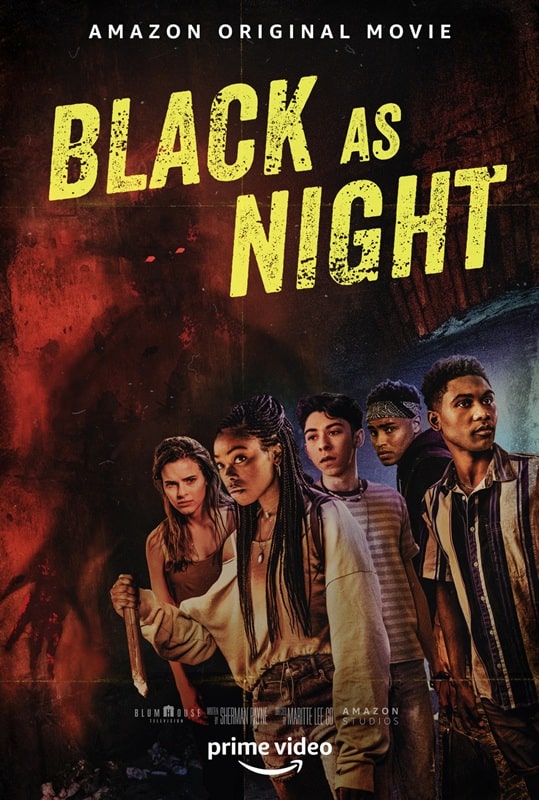
Vampie: The Silliest Vampire Movie Ever Made (Beautiful Rebellion Films,
February 14, 2014) and Black as Night (Amazon Studios, October 1, 2021)
Note, ‘Vampie’ is pronounced ‘Vam Pie’ as in ‘Meat Pie’.
I think we need to discuss the definition of ‘silly.’ When I think silly vampire movie, I think Mel Brooks’ Dracula: Dead and Loving It, or even Polanski’s Fearless Vampire Killers. A better alternative title for this one might have been Vampie: Mildly Amusing in One or Two Scenes. The rest of the time it’s a bit of a slog, hampered by a dodgy script and stilted line delivery. This is a shame, as writer/producer/star Ming Ballard and director Melissa Tracy have a potentially interesting concept, but not the chops (or budget) to make it work.
The story concerns Azure (Ballard), a centuries-old vampire who is allergic to blood. She runs a pastry shop with two friends, Tippy (Eric Strong), and Grace (Maya Merker, the highlight of the film).
Azure has a supernatural recipe item for a magical pie that she eats to stave off her blood hunger. When the pie ingredient is stolen by a rival vampire, she must get it back with the help of a Vatican assassin. That’s the plot in a nutshell.
Along the way, we get prolonged scenes of unfunny dialogue, unfunny flashbacks and a foul-mouthed chihuahua called Van Helsing. There are some moments of drama that are quite effective, but it was ultimately a chore to get through. Oh well.
4/10
Black as Night (2021) – PrimeHigh-schooler Shauna (Asjha Cooper, excellent), informs us via voiceover that what we are about witness is a crazy summer, one in which she got breasts, and killed vampires. This is no throwaway line in either respect. Shauna is 15 and riddled with anxiety, not only due to her own development, but the darkness of her skin (not helped by her brother who calls her Wesley Snipes in a wig), and her crush that she is too shy to talk to.
It’s a good way to start a film as her arc is clearly defined, but the main focus is shared between the vampires who prey on the homeless and addicted, and the after effects of Katrina, which continue to suck the very life out of the residents of this area of New Orleans. Part of the backdrop is The Ombreux, a rundown housing project that is home to junkies and the disenfranchised. This put me in mind of the Cabrini-Green inspired projects of Candyman, another film that explored the plight of black citizens framed with horror themes.
Many topics are explored in Black as Night through dialogue and one impressive speech by David Keith that touch on racism, gentrification, slavery and poverty, and these heavy issues are balanced with a frothy, Buffyesque romp featuring Shauna and her gang (best gay friend Pedro, crush Chris and vamp lit boff Granya). Moments actually put me in mind of Fright Night (inexperienced youths enter a forbidding mansion to kill bloodsuckers) and I enjoyed myself.
It’s not all great though, one villain was woefully underused, the narration started to outstay its welcome, and the actual horror was a bit lackluster, but overall, a solid film from director Maritte Lee Go, and I’m interested to see what she gets up to next.
7/10
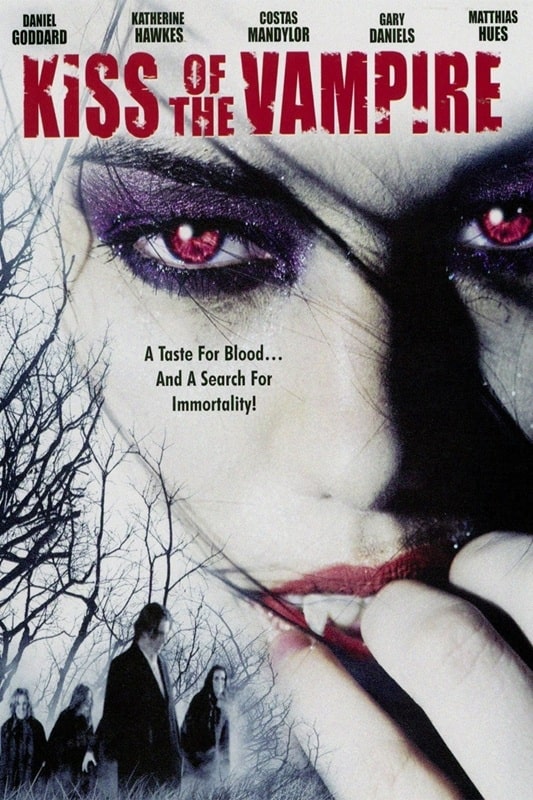

Kiss of the Vampire (Immortally Yours, January 6, 2009) and Renfield (Universal Pictures, April 14, 2023)
Ugh — we reach the halfway point and I want to chew my leg off.
I’ve stated before that I try not to rag too much on bad films, because I know first-hand how hard it is to make one (good or bad), but this one just annoyed the hell out of me. Despite having enough in their budget to lob a couple of thousand at Costas Mandylor (Saw series) and Martin Kove (everything else), the rest of the budget must have gone on craft services, because it definitely didn’t get spent anywhere else.
Especially not on sound. Scenes are barren and poorly miked, and the costumes came straight from Ruby’s Halloween bargain bin. The effects are tragic, the acting lacklustre and the story is nonsensical. I’m sure the actors were told they were making an epic based on Twilight and Underworld, with the Illuminati thrown in, but they ended up in a convoluted mish-mash of ideas, none of them concluded satisfactorily.
Avoid.
Or watch, if you’re full of self-loathing.
2/10
Renfield (2023) – PrimeA lesson to be learned here about getting your hopes up. I was pretty excited to see this one, as I desperately want Universal to have a hit (The Invisible Man is the only one they haven’t screwed up), and I love Nicholas Hoult, Nic Cage and Awkwafina (to a degree).
I knew going in that the tone would be irreverent, but I had no idea how slapstick they were going to go with the horror (an impressive blend of practical and CG), or that Cage was going to portray Dracula as if he was in Carry On Count.
I thought the concept was excellent (if a little flimsy), however I would have really dug a film closer in tone to Ready or Not or Werewolves Within. Everyone just needed to dial the lampooning down two notches. Ah well.
7/10


Vampires vs. The Bronx (Netflix, October 2, 2020) and I Like Bats (Zespół Filmowy, 1985)
Zoe Saldana is listed in the opening credits, and is gone after 2 minutes. Hey, it’s a good name to bait investors with, so fair play to them.
Vampires vs. The Bronx brings nothing new to the table, it evokes the kids vs monsters theme of Attack the Block and Lost Boys (even emulating Greg Cannom’s Lost Boys vampire makeup), makes several references to Blade (and copies its gnarly deaths), and is littered with in jokes (the realtor firm is called ‘Murnau’, and their logo is Vlad himself).
It might be derivative, but it also skips along at a fair old pace, helped by a charismatic group of child actors and a tongue-in-cheek script. The vampire front is a realtor company (headed by Shea ‘Skull Island’ Whigham) and the metaphors fly thick and fast as the Bronx rapidly succumbs to the soul-sucking practices of gentrification.
It’s fun, horror-lite, gateway fare for younger viewers who might be vamp-curious, and one of the few Netflix productions that doesn’t rely on green and purple gels. Worth a look if you’ve got a spare 90 mins.
7/10
I Like Bats (Lubię nietoperze) (1985) – PrimeIt’s off to Poland now, for a strange little film that can’t quite settle on a genre or tone. It’s a game of two halves, the first being the infinitely better one, but we’ll get to that.
Katarzyna Walter is Izabela, a vampire whose raison d’être seems to be ridding the world of scumbag men. General creeps, stalkers, would-be rapists, and murderers are first seduced and then sucked dry by Iza, whose overbearing aunt persistently complains about the lack of men in her life.
I enjoyed this half — with Iza in the role of avenging angel. It’s moody, gothic and beautifully shot. It also feels timeless — scenes of the contemporary town could be from decades before the mid-80s, and some clothing and vehicles feel anachronistic, but one character mentions AIDS, and we are jolted back to the correct setting.
The second half of the film is where things go awry. Iza checks herself into a psychiatric hospital in an effort to become human because she has fallen in love with the head doctor. They don’t believe her of course, however, she can’t be hypnotized or x-rayed and is soon biting the workers (her first victim is the lothario gardener who shags all the nurses in the tomato house). Then, all of a sudden, Iza is settled in domestic bliss. And that’s it.
A bit of a curio, recommended for certain types. Not saying who.
5/10
Previous Murky Movie surveys from Neil Baker include:
You Can’t Handle the Tooth, Part I
Tubi Dive
What Possessed You?
Fan of the Cave Bear
There, Wolves
What a Croc
Prehistrionics
Jumping the Shark
Alien Overlords
Biggus Footus
I Like Big Bugs and I Cannot Lie
The Weird, Weird West
Warrior Women Watch-a-thon
Neil Baker’s last article for us was Part I of You Can’t Handle the Tooth. Neil spends his days watching dodgy movies, most of them terrible, in the hope that you might be inspired to watch them too. He is often asked why he doesn’t watch ‘proper’ films, and he honestly doesn’t have a good answer. He is an author, illustrator, teacher, and sculptor of turtle exhibits. (AprilMoonBooks.com).
The Remarkable 4 Books of Pellinor by Alison Croggon
Reviewer Emmie Finch on the books of Pellinor, by Alison Croggon. Pellinor – The Naming,…
The post The Remarkable 4 Books of Pellinor by Alison Croggon appeared first on LitStack.
Tor Double #9: Isaac Asimov’s The Ugly LIttle Boy and Theodore Sturgeon’s The [Widget], the [Wadget], and Boff
 Cover for The Ugly Little Boy by Alan Gutierrez
Cover for The Ugly Little Boy by Alan Gutierrez
Cover for The [Widget], the [Wadget], and Boff by Carol RussoThe ninth Tor Double collects novellas by Isaac Asimov and Theodore Sturgeon, the only entries by either author. The Asimov’s story is The Ugly Little Boy and Sturgeon offers the oddly titled The [Widget], the [Wadget], and Boff. This volume is the first to include two stories that did not win, or even receive a nomination, for any awards. Leigh Brackett’s story in the previous volume wound up winning the 2020 Retro Hugo Award.
Theodore Sturgeon’s The [Widget], the [Wadget], and Boff was originally published in F&SF in November, 1955. The strange title is entirely fitting for the strange story Sturgeon has to tell. Just as two of the words in the title are framed by brackets, the story has a science fictional device framing it, in the form of a report by two aliens visiting Earth. In their report, which partly looks at whether or not “Synapse Beta sub Sixteen” exists in humans (and whether the species can survive without it), but also serves as an indictment of one of aliens by the other, the aliens set words in brackets when there is no exact English equivalent for what they are attempting to say.
The story framed by this conceit could have been published in any of the mainstream magazines. It tells the story of the residents of a boarding house in a small town. Bitty and Sam Bittelman run the house, which has gathered its fair share of misfits. Tony O’Banion is a successful lawyer whose privileged upbringing gets in his way, Mary Haunt is a movie star wannabee who is waiting for her break, Phil Halvorson has undefined issues, but seems to be either gay or asexual in a world which sees both as a perversion, Miss Schmidt is a school librarian who keeps to herself, and Sue Martin is a hostess in a nightclub. Sue’s three-year-old son, Robin, creates a connection between the characters.
Robin is an easy going child, whose happiness with the world around him causes most of the residents of the boarding house to adopt him. When his mother is sleeping during the day, the Bittelman watch over him. If they aren’t available, “Tonio Banion” tries to make time for him, taking him along of visits to a local amusement park where O’Banion provides legal services. Miss Schmidt cares for him at night when Sue Martin is at work.
Although Robin is not a view-point character in the story, Sturgeon does an excellent job of presenting his world view, from his mishearing O’Banion’s name as Tonio to his anthropomorphizing of kitchen appliances, such as Mitster (a mixer) or Washeen (the washing machine). Robin also has two imaginary friends, the titular Boff and Googie.
As the story progresses, Sturgeon’s focus on the residents of the boarding house slowly builds up the complexity of their relationships and personal problems. Many of the characters receive a spotlight, either as Sturgeon explores their activities or inner thoughts or when they have conversations with Bitty or Sam, both of whom have a tendency to ask probing questions of their boarders that make them reconsider their lives and choices. At the same time, Bitty and Sam are never shown as prying or anything less than nurturing.
The result is that even as their boarders begin to come to terms with the realities of their existence, either dreams that cannot be attained or the manner in which they are standing in the way of the own success, the story starts to feel more hopeful. Once their issues are realized, they are more likely to be able to take care of them. Throughout the story, reports from the two aliens who are watching them also continue to play a role, giving the indication that the growth of the individuals is caused, at least in part, by the “Synapse Beta sub Sixteen” the aliens are looking out for.
Boff and Googie are woven throughout the story, and while Robin is always aware of their activities and location, as imaginary friends, they are either dismissed or patronized by the adults in the story. The reader, aware that Boff’s name appears in the stories title, realizes that there is an importance to the characters and the manner in which the nature of Robin’s imaginary friends is revealed is clever and ties in quite well to his way of seeing the world through the eyes of a three year old.
Even if the revelations each of the characters have about themselves in response to the Bettelman’s questions can’t be considered a happy ending, each of the characters appear to be in a healthier place when the story ends, having come to terms with their position in life and finding a way to continue further in a way which will not leave them more damaged than they were at the beginning of the story.
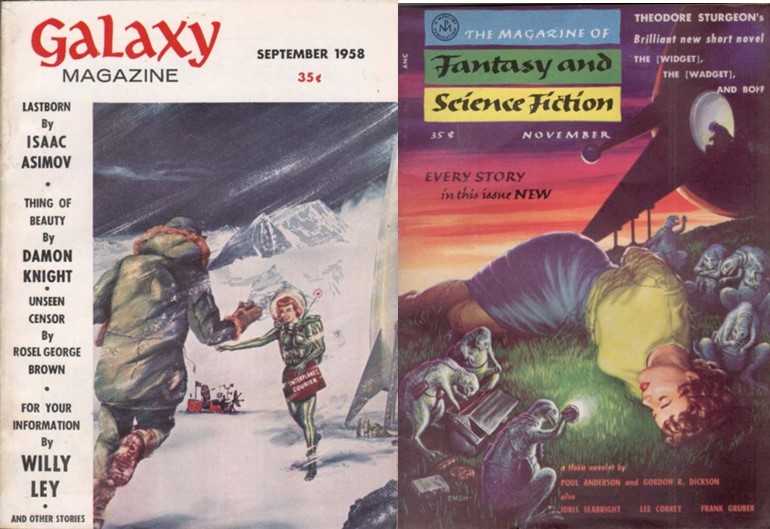 Galaxy Magazine September 1958 cover by Dember
Galaxy Magazine September 1958 cover by DemberThe Magazine of Fantasy and Science Fiction November 1955 cover by Ed Emshwiller
The Ugly Little Boy was originally published as “Lastborn” in Galaxy in September, 1958. It was nominated for the Hugo Award and the Nebula Award, winning the latter. In 1991, Robert Silverberg would publish an expanded, novel length version of the story, retitled Child of Time (although the American version of the novel would retain the title The Ugly Little Boy.
Just as three-year-old Robin is to center of The [Widget], The [Wadget] and the Boff, the titular boy in Asimov’s story is also three years old when his story begins, or at least in the flashback that shows how he got into the situation the story covers.
Edith Ffellowes is a nurse who has been hired by a company called Stasis, Inc. under the assumption that their first experiment, to bring a Homo neanderthalensis to the contemporary period. The CEO of Stasis, Inc., Gerald Hoskins, hires Ffellowes after a cursory interview in which he is mostly concerned over whether she loves all children or just pretty children. It isn’t until she shows up for the attempt to retrieve the child that she begins to understand the actual details of the job for which she has been hired.
Although Ffellowes is taken aback by the boy’s appearance when she shows up, she is a professional and works to take care of him, cleaning him up and attempting to engage with him despite the language barrier. By bringing a three year old rather than an adult, Asimov is able to ignore the cultural issues which would have arrived by bringing in a fully functioning member of Neanderthal society. It also gives him the opportunity to have Ffellowes attempt to educate the boy, who she names Timmie in a failed attempt to stop the press from referring to him as an ape-boy.
The primary purpose of Stasis, Inc’s, experiment was to bring a living creature from the Neanderthal period to the modern time, and they succeeded. The secondary purpose was to learn about Neanderthal culture and physiology. Although the latter was possible from their experiment, a three-year-old will not be able to teach them much, especially one who’s culture is infected by the teachings of a modern woman.
As the story progresses, Ffellowes works to socialize Timmie, including asking Hoskins to allow him to interact with a modern human boy of the same age. Although the initial meeting between Timmie and Hoskins’ own son, Jerry, does not initially go well, eventually the two build up a friendship of sorts, although there is always an undercurrent of tension brought on due to the differences between the boys and Hoskins’ own attitude toward Timmie. Although he generally says the right things to Ffellowes about her charge, he occasionally indicates that he sees Timmie a less than human.
Asimov’s focus with the story is on Ffellowes and the relationship she builds up with Timmie. Even as the world sees him as an ape-boy, she fights for his dignity and to teach him how to be a person. Asimov’s is less interested in the impact their relationship has on Timmie’s way of thinking, taking the point of view that there is no difference between a three year old Neanderthal and a three year old human are essentially the same, except for their physical appearance.
He also doesn’t seem to be overly interested in the ethics of Hoskins’ experiment. Hoskins’ questionable scientific ethics are apparent from the beginning, when he hires Ffellowes with only the briefest of interviews and without providing her with the information that she would need to make an informed decision. Throughout the experiment, he shows little more interest in Timmie than he does in the inorganic material Stasis also brings through, eventually attempting a similar experiment with a fourteenth century Italian, demonstrating that from an ethical point of view the company has learned nothing.
Written in Asimov’s clear style, it is similarly clear why Robert Silverberg expanded the story into a novel 34 years after its initial publication. The story is overly simplistic, offering hints and weighty issues that it could address. Similarly the understanding of Neanderthal culture advanced in the intervening years. Silverberg’s focus was more on the Neanderthal period than the ethical concerns regarding Hoskins and Stasis, Inc.’s methodology.
The cover for The Ugly Little Boy was painted by Alan Gutierrez. The cover for The [Widget], the [Wadget], and Boff was painted by Carol Russo.
 Steven H Silver is a twenty-one-time Hugo Award nominee and was the publisher of the Hugo-nominated fanzine Argentus as well as the editor and publisher of ISFiC Press for eight years. He has also edited books for DAW, NESFA Press, and ZNB. His most recent anthology is Alternate Peace and his novel After Hastings was published in 2020. Steven has chaired the first Midwest Construction, Windycon three times, and the SFWA Nebula Conference numerous times. He was programming chair for Chicon 2000 and Vice Chair of Chicon 7.
Steven H Silver is a twenty-one-time Hugo Award nominee and was the publisher of the Hugo-nominated fanzine Argentus as well as the editor and publisher of ISFiC Press for eight years. He has also edited books for DAW, NESFA Press, and ZNB. His most recent anthology is Alternate Peace and his novel After Hastings was published in 2020. Steven has chaired the first Midwest Construction, Windycon three times, and the SFWA Nebula Conference numerous times. He was programming chair for Chicon 2000 and Vice Chair of Chicon 7.
COVER REVEAL: Liminal Monster by Luke Tarzian

Preorder Liminal Monster over HERE
Add Liminal Monster on Goodreads
Luke Tarzian has graced us with the cover for this newest story titled LIMINAL MONSTER. Firstly here's the blurb for it

Plus here's the snazzy cover for it which has been created by the author himself

For those reviewers who might be interested to review it, the author has set up an e-ARC request form over here.
A Kind Heart and the Right Sort of Hands: Carbonel, the King of the Cats by Barbara Sleigh
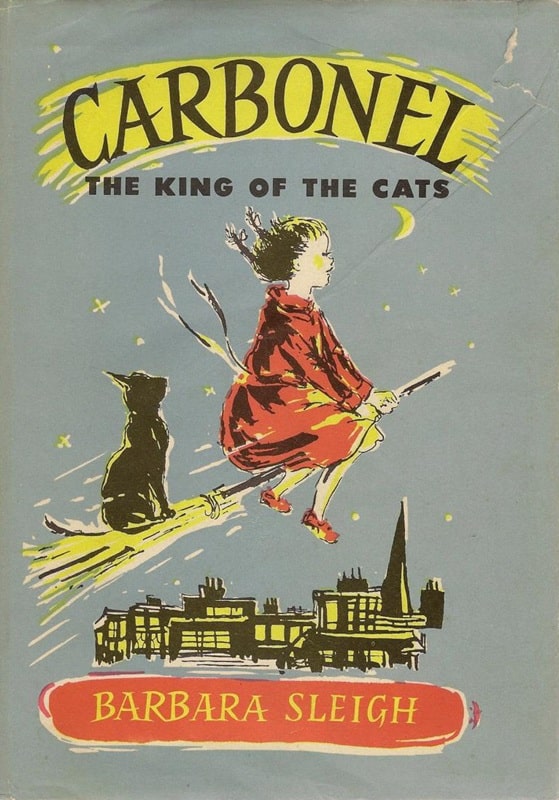 Carbonel the King of the Cats by Barbara Sleigh (Bobbs-Merrill Company, 1957). Illustrated by V.H. Drummond
Carbonel the King of the Cats by Barbara Sleigh (Bobbs-Merrill Company, 1957). Illustrated by V.H. Drummond
Over the past few years, I’ve started tracking down books I read as a child and still remember, to see what I think of them now. Some of them I’ve had to buy; but I live close to a university library, which still has others on its shelves. I just reread Barbara Sleigh’s Carbonel, the King of the Cats (illustrated by V.H. Drummond), originally published 1955, and enjoyed it enough to think it deserves a review.
Sleigh was clearly an aelurophile; this book is dedicated to one cat and to the shades of four others. I’m pleased that its feline hero, Carbonel, is a black cat (as his name suggests!) — a breed that doesn’t get as much love as it deserves. He has very convincing catlike manners, mixing condescension, sarcasm, and occasional affection. At the same time, he fits one of the classic story formulas, being a lost heir of royal birth, with a title that he hopes to reclaim.
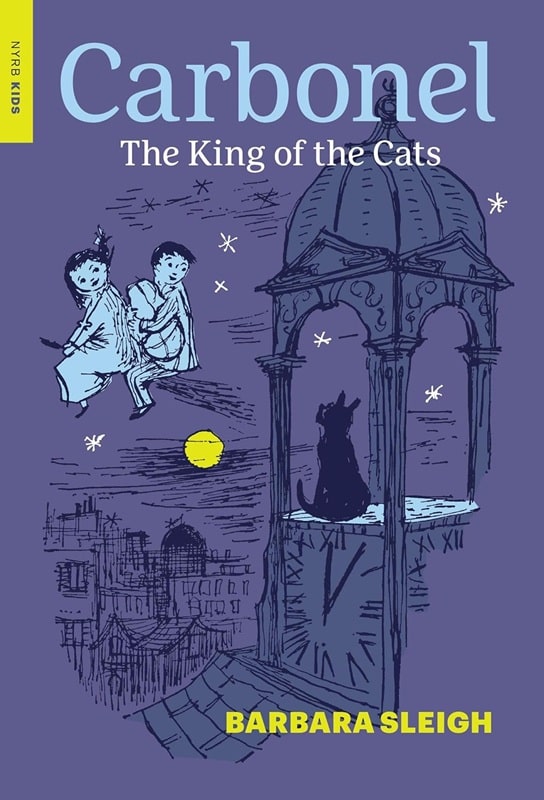 Carbonel the King of the Cats paperback edition (New York Review of Books, August 7, 2018)
Carbonel the King of the Cats paperback edition (New York Review of Books, August 7, 2018)
But the novel’s other hero is human: Rosemary Brown, a girl of ten, the daughter of a widow who supplements her pension by working as a seamstress. (Given the novel’s publication date, Rosemary’s father may well have died in the Second World War.) This is another classic formula, the child growing up under straitened circumstances — one that was still with us in Harry Potter and the Philosopher’s Stone (a much better title than the American Sorcerer’s Stone).
I have to say that Rosemary is more enterprising than Harry: When her vacation from school begins, she comes up with the idea of finding some sort of work to earn money at, in order to help her mother. (Though to be fair, there might have been far fewer obstacles to such a project in 1955 than in 1997.)
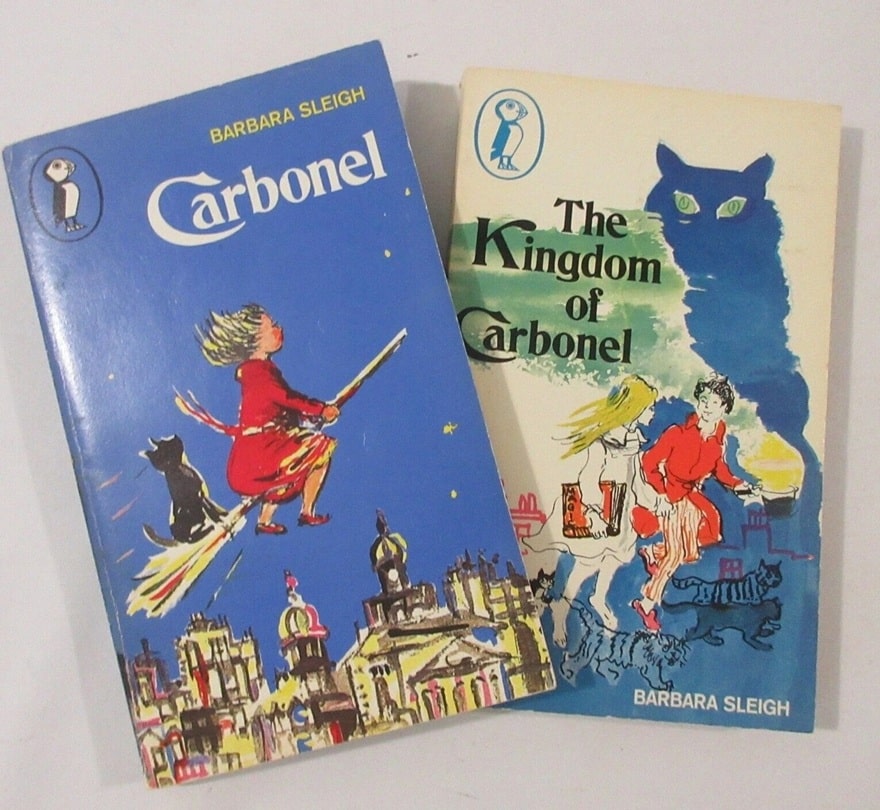 Carbonel and its sequel The Kingdom of Carbonel (Puffin paperback editions, June 1961)
Carbonel and its sequel The Kingdom of Carbonel (Puffin paperback editions, June 1961)
In any case, that’s where the adventure begins: Rosemary decides that she could earn something by cleaning and sets out to buy a broom with the contents of her money box. As it turns out, what she gets is a witch’s broom, and one that’s crudely made, with a bundle of twigs at the sweeping end, and on the verge of falling apart.
But she also gets the witch’s cat, with her last three farthing, and learns that the broom not only flies, but grants her the power to understand what the cat says to her. Unfortunately, it’s not suited for the kind of indoor cleaning Rosemary has in mind: It looks more like a gardener’s broom.
 Illustration by V.H. Drummond
Illustration by V.H. Drummond
But Carbonel, the cat, brings his own complications: He’s still bound by a spell the witch cast on him, and can’t reclaim his heritage and give the feline kingdom a proper ruler until he’s set free. And the conditions for doing so entangle Rosemary and her newly made friend John (the nephew of one of her mother’s customers) in a long series of complications.
I thought they were ingeniously worked out and had just the kind of odd magical prohibitions that are proper to a fairy story; and the resolution of Sleigh’s plot also resolves several other issues that came up earlier, from a small theatrical troupe’s troubles to the career of a retired witch. I really thought this book showed a lot of ingenuity in tying everything together.
 Carbonel the King of Cats
Carbonel the King of Cats
I was also struck by a point I missed when I read this as a child, because of the other things I hadn’t read: In one chapter John figures out something significant and cites a maxim of Sherlock Holmes’s to explain how he did it — one from “A Scandal in Bohemia,” the story that gave us Irene Adler. I don’t know if I would have understood a story about royal love affairs and potential blackmail when I was 10, and perhaps John doesn’t, either. But clearly at least part of the story stayed with him.
Sleigh does a good job both of making the reader sympathize with Rosemary, and through Rosemary’s own sympathy of making the reader sympathize with Carbonel. Both of them were entertaining characters, and they made me feel that my private project is being worthwhile.
William H. Stoddard is a professional copy editor specializing in scholarly and scientific publications. As a secondary career, he has written more than two dozen books for Steve Jackson Games, starting in 2000 with GURPS Steampunk. He lives in Lawrence, Kansas with his wife, their cat (a ginger tabby), and a hundred shelf feet of books, including large amounts of science fiction, fantasy, and graphic novels. His last article for us was a review of Dorsai! by Gordon Dickson.
Spotlight on “The Secret Market of the Dead” by Giovanni De Feo
The Secret Market of the Dead is an Italian-inspired gothic historical fantasy about a young…
The post Spotlight on “The Secret Market of the Dead” by Giovanni De Feo appeared first on LitStack.
Book Review: Scales by Christopher Hinz
I received a review copy from the publisher. This does not affect the contents of my review and all opinions are my own.
Mogsy’s Rating: 3 of 5 stars
Genre: Science Fiction, Thrillers
Series: Stand Alone
Publisher: Angry Robot (April 8, 2025)
Length: 432 pages
Author Information: Website
Before I get into the meat of this review, I’ll admit I feel a little bit duped. When I first saw the book’s blurb pitching Scales as a perfect read for fans of Jurassic Park, I’d initially pictured rampaging dinos. The truth is actually something quite different. While I would still classify this novel as a techno-thriller, and there was no doubt some bioethical questions involved, its premise nonetheless puts it more in line with military sci-fi, super soldiers, and covert ops fiction. That said, once expectations are readjusted, you may yet find a certain appeal to this high-octane action thriller.
The story follows Eddie Boka, a U.S. soldier turned genetically modified superhuman as part of a classified military experimental program fusing human and dinosaur DNA. After going through the genetic modifications, he and three other volunteers for the program are gifted with enhanced strength, more acute senses, and scaly armor, making them deadly and durable combatants on the battlefield. However, these newfound talents also come with an unfortunate side effect. Dubbed the bloodburn, it is a primal compulsion that takes over during combat, and it strikes Eddie during his first mission. While carrying out an attack on a guerilla camp, he loses control, giving in to a violent and animalistic urge to devour one of his victims. Alarmed, the researchers behind the program realize they must address this gruesome development before introducing their dino-human hybrids to the public. After all, it would be extremely difficult to generate support if people were to find out Eddie and his peers harbor a tendency towards cannibalism.
Thus, enter Adelaide LaTour. A controversial psychotherapist, Addi is the inventor of an effective but much maligned treatment process involving conditioning with what is essentially a very powerful shock collar. By inviting her to the research complex to work with Eddie, his handlers hope that her unorthodox methods will help tamp down the bloodburn and its undesirable urges. And yet, what neither Addi nor Eddie anticipated was the bond that forms between them, one that eventually deepens into something more. Meanwhile, as their forbidden romance grows even more complex, the facility’s darker secrets are also beginning to surface. Hidden experiments that have been kept buried by the megalomaniacal scientist behind the program are ultimately exposed, threatening the future and lives of human-dino hybrid soldiers like Eddie.
From the jump, this story throws readers into a fast-paced adventure that rarely lets up. Hinz is in his element and appears most comfortable when he’s writing action like covert mission detail and close-quarter combat situations, appearing to have a strong grasp of the genre’s expectations. The book is also most compelling when it explores Eddie’s physical transformation and the bioengineering experimentation that happens behind the scenes, and there’s a subtle yet intriguing thread of ethical questions underlying this premise, exploring the issues of control, consent, and institutional overreach.
However, beyond this is where the novel starts to falter. As much fun as I had with the action, something felt missing: depth. For one, there is a distinct lack of emotional substance as characters rarely show much of themselves underneath the surface, acting more like archetypes than real people. Eddie is the tortured and noble soldier, who is good at heart but made some mistakes in his youth. Addi is the brilliant but morally ambiguous therapist, who is more concerned about her reputation than she lets on. Sure, these labels are easy enough to apply, but what led them to be this way? We don’t really know, because the story never goes deeper. Side characters are even more roughly sketched, filling cookie cutter roles like “mad scientist” or “hard-ass military commander.”
To be honest, this is all fine if you’re okay with a book equivalent of a mindless summer Hollywood blockbuster, but Scales really pushed its luck when it came to the romance between Eddie and Addi. Not surprisingly, when you put two thinly developed characters together, the result is you get zero chemistry and an unnatural, unconvincing relationship that ultimately feels like a rush job. And it’s a shame, really. It’s as though Hinz’s instincts told him his novel needed a love story, but he couldn’t quite write one in with genuine feeling.
Needless to say, the book also requires you to suspend your disbelief, though to be fair, that’s a pretty standard prerequisite when it comes to sci-fi thrillers of this type. Much of it is also entertaining, but in many ways makes it feel more like reading a comic book or watching a movie rather than a novel, and no doubt the author’s comics and screenplay writing background plays into this. Everything might feel bold and loud, yet the words are missing that special ingredient that gives the prose presence and polish.
In the end, Scales was a decent read. It’s popcorn fiction in every sense of the term, featuring big ideas, big stakes, and big action, even if it doesn’t fully commit to exploring much beyond the surface. There’s no doubt a lot of entertainment to be found here, especially if you don’t mind a bit of genre absurdity. For me, this was a perfectly average read, though I did appreciate the diversion.
![]()
![]()
A Hand-Crafted World: Karel Zeman’s Invention for Destruction
Is there anything more dispiriting than the ceaseless quest for novelty, especially when it seems bound to end in disappointment? It’s something I feel just about every time I turn on the TV. We’ve never had so many viewing choices, but so often everything feels reheated, recycled; we’ve seen it all before. The genuinely different is so rare that when you do see it, you know it — and you never forget it.
Sometime in the 70’s I saw an old black-and-white movie on television; it was called The Fabulous World of Jules Verne and it was the most extraordinary-looking thing I had ever seen. Guess what? I never forgot it.
A few years later I saw a movie on the late-night tube about the world’s greatest liar, Baron Munchausen. This time I couldn’t say that I had never seen anything like it because there was one thing that it reminded me of — The Fabulous World of Jules Verne. It was only years later that I learned that both films were the work of the Czechoslovakian director, Karel Zeman.
Zeman was born in 1910 in Austria-Hungary, and after spending most of his twenties working in advertising in France, in 1936 he returned to his home in what had become Czechoslovakia and began to work his way into the film business. He managed to survive both the Nazi occupation of his country during World War Two and the following grey decades of Czech subserviency to the Soviet Union, making films, both shorts and full-length features, that existed in — that created — a stubbornly non-political realm of beauty and humor and eccentric individuality. He died in 1989, shortly before the collapse of the Eastern European satellite regimes.
A few years ago, Criterion released Jules Verne under its original 1958 title, Invention for Destruction, along with 1962’s The Fabulous Baron Munchausen and another Zeman film, 1955’s Journey to the Beginning of Time, in a beautiful Blu-ray set titled Three Fantastic Journeys by Karel Zeman. It has a place of honor on my shelf, and it deserves one on your shelf, too, for Invention for Destruction alone; I guarantee it really is like nothing you’ve ever seen before.
Exactly what was it that I found so striking, so indelibly memorable about Invention for Destruction? What still makes it a jaw-droppingly unique movie, even after all the cinematic and technological innovations of the past seven decades? What made it the most internationally successful Czech film ever (a propaganda success that blessedly kept the cultural commissars off his back)?
Well, imagine that you’re looking at an old book, let’s say a volume of Jules Verne, lavishly illustrated with quaint nineteenth-century steel engravings. Now imagine that those obsessively, almost insanely detailed black-and-white images of Verne’s incredible creations begin to move, begin to assume a reality that overflows the pages of the book to finally become the entire visible world. That’s Invention for Destruction.
Zeman lays his cards on the table in the first scene of the movie, which begins with a narrator browsing through a volume of Verne, looking at page after page of illustrations, until the last one, an engraving of a steamship at sea, begins to move; while still retaining all of the sharp-edged, fine-lined qualities of the original picture, the waves roll, the sidewheel turns, smoke billows from the smokestack, and the camera cuts to the deck of the ship, where we meet our main character, an assistant to a renowned inventor, and the story is off and running. We have literally fallen into a book.
The achievement is all the more amazing because it was done, not with CGI, but with good, old-fashioned legerdemain, with practical effects and camera tricks that go back to the dawn of cinema.
In speaking of Zeman’s methods, Phil Tippett, who supervised the dinosaur animation for Jurassic Park, said,
He employed a technique where he would set up his shots in multiple planes — say you would have a stop-motion character or a live actor shot against… a flat that had painted on it this architecture, and maybe in front of that there would be cut-outs, kind of like a matte painting.
It sounds simple, but when you consider that the entire world of the film was created this way, that virtually every single shot consisted of these multi-layered set-ups, often combined with forced perspective and in-camera split screens, you begin to realize that such a film must have been fiendishly difficult to plan and shoot.
The ultimate effect is not realistic, but hyperreal (at times even hallucinatory), and the movie is filled with something that even the best CGI is unable to convey — the human wit and charm that only comes from something that visibly maintains its connection with the hands of the craftsman who shaped it.
Director and animator John Stevenson (Kung Fu Panda) summed up the Zeman difference perfectly:
Karel Zeman is one of the great magicians in cinema, right up there with Georges Méliès, with Willis O’Brien, George Pal, Ray Harryhausen, and he really should be considered part of that pantheon of people who put extraordinary images into the public consciousness. But what other people like George Pal, Ray Harryhausen, Willis O’Brien were trying to do — their illusions were designed to be as, if not “realistic”, as believable as possible; they wanted you to believe that somebody was fighting a dinosaur or being carried around by a twenty-five-foot gorilla. Karel Zeman invites and audience to come into a completely hand-made, hand-crafted world, and to accept that nothing they’re going to see looks believable or realistic… he was activating that part of the brain that allows you to make a fort out of the cushions of the settee and believe it’s a fort or get in a cardboard box and believe it’s a spaceship or a pirate ship.
Zeman’s highly stylized mixed-media method, his artful and humorous juggling of live-action, stop-motion, puppets, paper cut-outs and anything else he could think up, worked perfectly for Jules Verne (an author he loved as a child), allowing him to act as a master showman, giving us a buoyant nineteenth-century dream of mechanical progress… but a dream that may easily shade into nightmare if the anticipated progress does not take the course we want it to. (Hence the threat implicit in the double-edged title: an Invention, yes… but for Destruction.)
The movie’s plot is largely taken from Verne’s 1896 novel, Facing the Flag, a book that is often seen as a quasi-prediction of the atomic bomb. The novel blends science and geopolitics in a story in which an inventor creates an explosive that is far more powerful than any ever seen before. (Many of the film’s images are taken directly from the engravings that Léon Benett did for the first edition of the novel.)
Zeman (who co-wrote the script as well as directed) uses Verne’s tale as a Christmas tree on which to hang his delightful and amazing ornaments, and Invention for Destruction is a movie replete with wonders enough to satisfy the appetite of every boy — or girl — who ever loved a ripping yarn. (Zeman once said, “I have only one wish: to delight the eyes and heart of every child.”)
In the world as envisioned by Verne through Zeman, all of earth’s realms have been subdued and transformed by the hand of scientific man: the land is continually crisscrossed by steam locomotives, steam-powered automobiles, and in one indescribably odd scene, by camels on roller skates; the air is crowded with balloons, balloon-cycles, pedal-powered one-man airplanes, and enormous, dreadnought-like airships upheld by dozens of propellers; the sea is swarming with commercial steamships, warships, and submarines large and small – to say nothing of an enormous octopus or two, which, as every lover of Jules Verne movies knows, always spells trouble.
It’s a world with castles perched on rocky promontories from which innocent inventors are kidnaped at midnight at the behest of a monomaniac millionaire and spirited away to an isolated island, where they are forced to work on an enormous cannon which will enable the madman to blackmail the world with explosive shells which could obliterate entire cities.
Image after image is quirkily spectacular or spectacularly quirky. The most amazing sequence is probably the one in which a submarine rams a ship, sending it to the bottom, after which the sunken vessel is looted by divers riding pedal-powered underwater aquabikes… which are equipped with bells, just like any paperboy’s bicycle. The scene ends with an undersea swordfight and though it only lasts six minutes, it’ll take you three times that long to watch it because you’ll be backing it up every thirty seconds, which is true of the film as a whole, at least the first time you watch it.
Paradoxically, for me the movie’s most memorable and resonant image is one of its simplest. As our hero (the inventor’s assistant) and heroine (a young woman from a looted ship who is a prisoner on the island) escape in a balloon, the inventor thwarts his captor’s evil scheme by detonating one of the explosive shells and vaporizing the great gun, the evil millionaire, and the island itself. Zeman sums up the results of the inventor’s brave action in a beautifully eloquent shot: we see a gentleman’s silk top hat, the emblem of bourgeois nineteenth-century elegance, respectability, security, sail silently into the immense sky, becoming smaller and smaller… pause in its ascent… and then fall into the empty sea below.
As much as I trust my ability with words, in this instance I don’t think you should rely on my descriptions of Karel Zeman’s astonishing achievement, because I’m afraid my words aren’t up to the task — I think you should see for yourself:
Well, was I lying?
In this era when CGI has become so sophisticated, so pervasive, and so pro forma that it is increasingly incapable of genuinely surprising or delighting us, where filmmakers can show us literally anything and therefore there is often nothing that they can show us that really excites us, the work of Karel Zeman is a revelation and a tonic. It can awaken that much-maligned but very real thing, a sense of wonder, and it can truly make you feel like a kid again, looking with unclouded eyes at a world in which new marvels are waiting around every corner.
If you watch Invention for Destruction and his other fabulous films, I think you’ll agree that Karel Zeman achieved his ambition and more; his passion was so deep and his vision so inspired and his craft so meticulous that it’s not only the eyes and hearts of children that he succeeded in delighting.
Thomas Parker is a native Southern Californian and a lifelong science fiction, fantasy, and mystery fan. When not corrupting the next generation as a fourth grade teacher, he collects Roger Corman movies, Silver Age comic books, Ace doubles, and despairing looks from his wife. His last article for us was The Old-Fashioned Way: Tove Jansson’s Hobbit Illustrations
7 Author Shoutouts | Authors We Love To Recommend
Support Independent Bookstores.You can find Author Shoutouts on bookshop.org at LitStack Author Shoutouts. Here are…
The post 7 Author Shoutouts | Authors We Love To Recommend appeared first on LitStack.
Trope Subversion, Level: Master
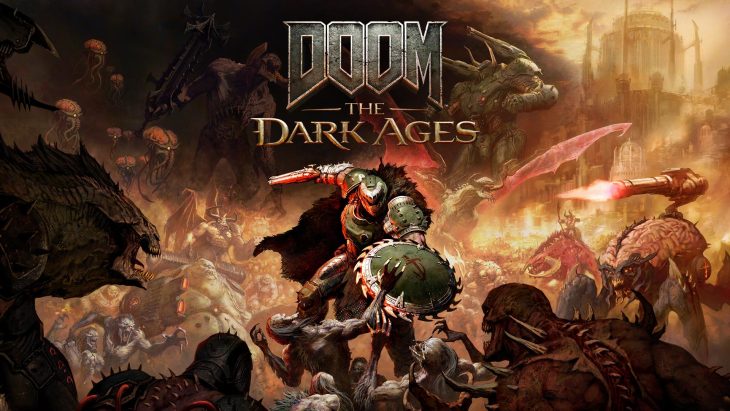
Good afterevenmorn, Readers!
If video games aren’t your thing, you’re not going to like my post today. With the release of Doom: The Dark Ages and let’s plays popping up all over my YouTube feed, I’m going to nerd out today about Doom for a moment. Actually, I’m going to nerd out about one specific cutscene in Doom: The Dark Ages because it flips a common horror trope to highlight the mythology of the main character so perfectly, I’ve been nerding out since I saw the clip during an episode of Jacksepticeye’s let’s play just a little over a week ago. Welcome to my new hyper-fixation.
Before I get into the scene exactly, we’re going to have to dive into the history and lore of Doom.
 Doom, Released 1993
Doom, Released 1993
The first Doom game released in 1993. To be perfectly honest, I had little to no interest in the game in 1993. I was not yet aware of what an incredible medium for story-telling video games can be. Besides, video games were for boys, and weren’t art anyway, so I wasn’t going to engage. Look, 1993 me was a bit of a snob… and very, very wrong. Mostly. Doom was (and remains) a hyper-violent game, which can be a bit much. But there is a story in there, and as the games progressed, the story has become increasingly well-written and executed. What is that story?
Well, an unnamed marine is sent to Mars as punishment for striking his commanding officer when his commanding officer ordered him to fire upon unarmed civilians. I immediately like the guy. On Mars and its moons Deimos and Phobos, the UAC (United Aerospace Corporation) is conducting teleportation experiments and they accidentally open a portal to Hell. Actual Hell. The hot place with all the demons and things.
Well, all those demons and things pour through, and it’s up to this punished marine to obliterate the Hellish host. Which he does, cutting through the demons like a man possessed. That was terrible. I will be here all week.
At the end of the the game, we discover the head of a white bunny on a pike — the unnamed marine’s (whom we’re now calling Doom guy) pet bunny Daisy, setting up an entirely fresh hatred for the armies of Hell (incidentally, I don’t think it’s an accident that John Wick’s puppy is called Daisy. Space Marine John Doe did not go John Wick on the minions of Hell, John Wick went all Doom Guy on the criminal underworld).
 Doom 2, Released 1994
Doom 2, Released 1994
In Doom 2, our hero Doom Guy is called into action again. Earth has been overrun, and he is once again called to take on the armies of Hell in an effort to save humanity. I believe that the two games are set very close together in the timeline. Fueled now by the rage engendered by the loss of his pet bunny (so goofy, and I love it. Also, he supposedly also lost his wife and child, but the big fuss is about the bunny. I’m still figuring that one out) as well as his own innate goodness, Doom Guy once again goes on a rampage. All the same frenetic gameplay and gore.
1996 gave us The Final Doom (it was not, in fact the final one). In this one the UAC, having learnt nothing, I guess, establishes a base on Jupiter’s moon Io. Once again, the UAC manages to open a portal to Hell, and Doom Guy is once again the one who comes to the rescue, tearing through Hell’s minions to save humanity. Poor guy. Bet he has some pretty hefty trauma from it all.
 Doom 64, Released 1997
Doom 64, Released 1997
A year later, and Doom 64 is released on the Nintendo 64. Doom Guy is pulled out of retirement to once again battle Hell. This time, he means for it to be for good (it was not for good). At the end of the game, after defeating the Demon Mother, Doom Guy realizes that the only way he can keep Hell’s forces away is to draw them away. In what can only be described as an incredible act of insanity (you thought I was going to say courage, right? Sometimes the two are indistinguishable), he elects to remain in Hell, fighting demons until he dies (he does not die).
And that’s where he remains. We learn in later games that he is such a savage in Hell, he has become their bogey man. He is their monster under the bed. Say his name in a magma pool three times and he appears behind you and takes your head off.
All is quiet on the Doom front until 2004, in which Doom 3 was released. No one can quite figure out how it fits into the timeline, and while the studio assures us that it is canon, our Doom Guy can’t be the protagonist. He is in Hell for this events of this game. The best fans have come up with is that it’s a different unnamed space marine. The world will never know his name. We salute you, brave sir.
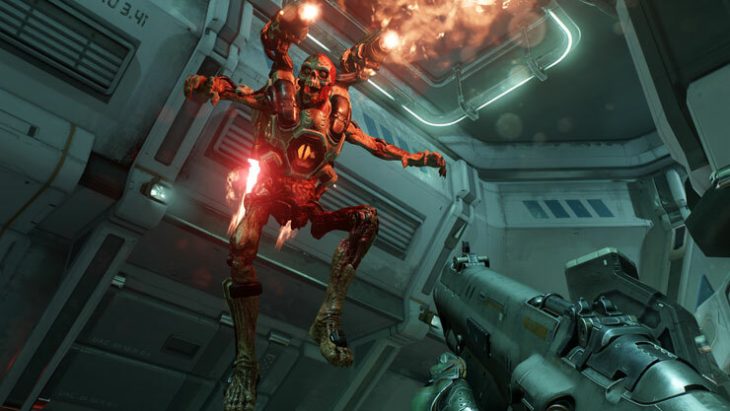 Doom 2016 – The soft reboot of the original
Doom 2016 – The soft reboot of the original
It’s another eight years before Doom returns to the gaming world. And this is where we start jumping around in the timeline.
In 2016 we get Doom (2016), and a return to the original Doom Guy. In this game, the UAC —Again! Someone take away their funding!— unleashes Hell again when a certain Dr. Pierce attempts to use Hell’s energy in order to solve an energy crisis on Earth. The obvious result is, of course, that Hell once again invades. In this game, Doom Guy has been sealed away in a sarcophagus for centuries, and has acquired a new moniker. Ladles and jelly spoons, introducing the Doom Slayer. He awakens in an overrun facility on Mars, and immediately begins to rip and tear (quite literally) through the demonic ranks.
This is the game where we start to get story cutscenes, and you’re expected to piece together the story from both these scenes and the gameplay. From this game, you get that the Doom Slayer is the avatar of rage. However, he saves that rage for the demons only. Humanity is safe from him.
With the help of the AI Vega, and UAC Scientist Dr. Hayden, who has managed to transfer his consciousness into an android, the Doom Slayer travels between realms, finds the Crucible (the weapon capable of closing the Well facilitating the invasion) and seal the Well. But Dr. Hayden turns on the slayer. After assuring him that the Well has been sealed, Hayden takes the crucible and teleports the Doom Slayer back to Mars in a betrayal that would surprise no one who paid attention during the game.
 Doom Eternal, released 2020
Doom Eternal, released 2020
Four years later, the next instalment in the Doom series is released. Doom: Eternal. Taking place after the events of Doom (2016), Doom: Eternal is where we start to get some depth to our protagonist. We discover that he survived his stay in Hell. Found by humans from the realm of Argent D’nur, he is a traumatized mess of a man. But the Sentinels (the knight-warriors) of Argent D’nur see in him a great deal of potential. He enters their ranks.
The gods of Argent D’nur are the Elemental Wraiths, but there are those who have begun to worship the Maykrs; basically techno-angels. They were allies at one time. We learn in one of the flashbacks that a rogue Maykr known as the Seraphim imbues the Doom Guy with near God-like power. This is how he became the Doom Slayer, instead of just Doom Guy.
In this game, the UAC has been thoroughly corrupted, becoming basically a Hell-worshiping cult. It is also revealed that the leader of the Maykrs has made a pact with Hell. In order to maintain the prosperity of the Maykrs, she has agreed to provide Hell with worlds to invade, in exchange for Argent power, created from the suffering of Human souls. And, well, she’s invaded Earth. Well, the Doom Slayer is having none of that. Time to rip and tear again.
And he does.
This is the important thing. Doom Guy, AKA the Doom Slayer, had thwarted Hell’s invasions thrice before going to live full time in Hell. He survived Hell, he made it out (was a complete wreck, but he made it out), he joined the ranks of warriors who battled Hell (before the Maykr’s betrayal), and then thwarted Hell again centuries later (in Doom (2o16)), and then AGAIN in Doom: Eternal, where he also obliterated the leader of the Maykrs. The man is too angry to die. No Hellion has managed to kill him. All who have faced him have perished.
Hell is terrified of him (and not just Hell).
And boy did the director make that plain in the cutscene of Doom: The Dark Ages that caught my attention and made me nerd out enough that I’m writing about it here… because I had to gush to someone, and you’re that person. Sorry and or you’re welcome.
(Doom: The Dark Ages is a prequel, taking place before the events of Doom (2016). The let’s play I’m following hasn’t concluded yet, so I’m not sure about the story exactly, so I can’t summarize it for you yet.)
The manner in which the cutscene plays makes it abundantly clear that the Doom Slayer is a monster to monsters. His entrance is reminiscent of countless horror movies. He cuts through a heavy locked door. The drop of his weapon, a flail, reminds me of the Witch King of Angmar as he faces Eowyn on the battlefield in Return of the King. The way he drags it on the ground, sparks flying, as he walks slowly towards his target (the demon Prince Ahzrak), is straight out of Silent Hill (Pyramid Head, anyone?). The way he keeps coming — an unstoppable force of nature— is reminiscent of Halloween.
Here, see for yourself:
The dude is a horror villain. Except he’s on our side. It flips the horror trope so beautifully that I was rooted to the spot while watching, and then immediately geeked out. And have been geeking out for about a week.
I cannot express how much I love this inversion. It’s excellent visual storytelling. Beyond everything you learn throughout the games, this one scene shows the player exactly who the Doom Slayer is, and what he is to the demons. He is not trapped in a facility on Mars with the armies of Hell. The armies of Hell are trapped in a facility on Mars with him. And it’s great.
Anyway, thanks for letting me nerd out for a moment. I’ve really made this a long one. You’re a champion if you made it all the way to the end. I don’t really have a question for you this time around. I’m still marveling over that cutscene. So instead, I’ll wish you all a wonderful day and an even better week.
When S.M. Carrière isn’t brutally killing your favorite characters, she spends her time teaching martial arts, live streaming video games, and cuddling her cat. In other words, she spends her time teaching others to kill, streaming her digital kills, and a cuddling furry murderer. Her most recent titles include Daughters of Britain, Skylark and Human. Her serial The New Haven Incident is free and goes up every Friday on her blog.
Spotlight on “Access” by Rebecca Grant
From the award-winning author of Birth, comes Access by Rebecca Grant, a journey into the…
The post Spotlight on “Access” by Rebecca Grant appeared first on LitStack.
By Crom: Marvel, Roy Thomas, and The Barbarian Life
So, back in January of 2022, I did a post on Roy Thomas and the Marvel Conan comic he created in the seventies. I never read that comic. But for some reason in 2019, I decided to buy the first of what turned out to be his three memoirs about the series (mostly about the first 115 issues, which constituted his first run with Conan), and also one of the Marvel Omnibuses that had been put out recently. I ended up getting four of the high-quality Omnibuses, which are those 115 issues he covered in his books.
And I just finished, a couple years later, the first 100, which culminated with the death of Belit, from “Queen of the Black Coast.”
I also recently started the Savage Sword of Conan Omnibus, which ran around the same time, and was black and white. It’s a more ‘literary Howard’ comic, and definitely different than the color Conan one (also less popular).
Below is the original post I did. Then, an additional section, having read through the first hundred. I think this comic is definitely a must for Conan fans. I prefer some of these stories to the Tor pastiches. They’re not all good, of course, but I have enjoyed my read through. And I cannot recommend enough, getting Thomas’ three books. Read one comic issue, then the accompanying short chapter from his book. It’s a terrific experience. Read on, MacDuff (a little literary malapropism for you).
One Black Gate series which I have started, but is still for somewhere down the line, is a look at the first dozen-or-so issues of Roy Thomas’ Conan the Barbarian comic. And even before running that series, I intend to write one for the second dozen-ish, so I can tie together the various overlaps. This was prompted by a combination of the over-sized Marvel hardback Omnibuses, and Roy Thomas’ TERRIFIC (now) three-volume memoir about the series, from Pulp Hero Press.
I never read the series, growing up. I bought some of the Dark Horse collections, which I liked. And when Marvel reacquired the rights and put out that first door-stopper compendium, I bought it. And I liked it enough to get the next three. I was buying them in conjunction with Roy Thomas’ Barbarian Life. The first Thomas volume covered the genesis of the comic, and the first fifty-one issues – which happened to be the same ones included in the first Omnibus.
Thomas helmed the series for 115 issues – which is how many are covered by the first four Omnibuses (both series’ talk about other issues as well). So, Thomas’ three books complement the Omnibuses perfectly. I read a story, and then I read Thomas’ insights. Along with the relevant commentary in the Omnibus itself. It’s a real Conan treat!
Thomas would write other color Conans for Marvel, and return to it over the years. And he would also contribute to Dark Horse while they had the rights. But it’s that first run, when he was Stan Lee’s right hand, and he made Conan a best-selling property for Marvel, which fans revere.
At the same time, Thomas was running the black-and-white The Savage Sword of Conan, (originally Savage Tales. That’s another post some day)which was more risque, and told a more in-depth story (LOTS of words). It’s a very different experience than Conan the Barbarian, and Marvel has collected those in Omnibuses as well.
Conan the Barbarian ran for 275 issues, from 1970 to 1993. That’s pretty amazing, as when it debuted, Conan was not the well-known figure he is today.
Here’s an excerpt from the first part of the planned Black Gate series:
An awful lot of people were introduced to Robert E. Howard’s Conan (best known as ‘The Barbarian’) through L. Sprague de Camp’s paperback series first from Lancer, and then, Ace. They featured those fantastic Frank Frazetta covers that are still popular today.
And in the early eighties, Arnold Schwarzenegger starred in two popular Conan movies that set the standard for fantasy movies until Peter Jackson’s amazing Lord of the Rings trilogy. The sword-swinging former governor of California is the image of Conan many people still have today.
In between those two ‘sources,’ came Marvel Comics’ Conan the Barbarian, with Roy Thomas in charge for the first 115 issues of a much longer run.
De Camp is justly criticized for rewriting Howard’s prose: Robert E. Howard did not need to be ‘edited.’
He has taken somewhat less-justified abuse for the Conan pastiches he wrote – by himself, and with Lin Carter, and Byron Nyborg. While they certainly can be criticized, in general; they deserve to be more fairly assessed than they are, I feel. I like most of them.
While Director John Milius did incorporate some elements from Howard’s original stories, Schwarzenegger’s Conan is a far cry from the original creation. Thomas co-wrote a screenplay for the second Conan movie, but Milius didn’t use it. It forms the basis of The Horn of Azoth comic book, from Marvel.
And Roy Thomas and Barry Smith certainly created their own version in the comics. But Thomas liked Howard’s writing and included much of it. Even though it didn’t feature a superhero, Marvel’s comic was one of the most popular of the seventies and eighties, unlikely as that seems. As is the case with de Camp’s paperbacks and Schwarzenegger’s movies, the Conan comic book was how many people discovered the sword-swinging barbarian. And its importance in the history of Conan cannot be minimized.
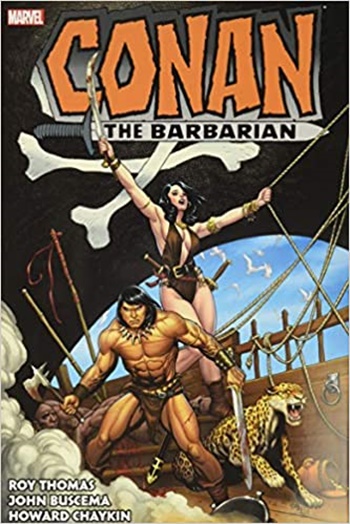 I’ve always got a couple of things in the works for here at Black Gate, but I’d really like to get to this Marvel Conan the Barbarian (CtB) series. Is the comic canonical? – no. But Thomas really draws on the source material. And not just the original Conan stories. I’ve already written a 1,500-word essay on The Grim Grey God, which is one of my favorite REH historicals. And it was adapted for Marvel issue number three. It’s terrific! Thomas (with some effort and wrangling) also got to use some of de Camp’s stories as well.
I’ve always got a couple of things in the works for here at Black Gate, but I’d really like to get to this Marvel Conan the Barbarian (CtB) series. Is the comic canonical? – no. But Thomas really draws on the source material. And not just the original Conan stories. I’ve already written a 1,500-word essay on The Grim Grey God, which is one of my favorite REH historicals. And it was adapted for Marvel issue number three. It’s terrific! Thomas (with some effort and wrangling) also got to use some of de Camp’s stories as well.
I’ve read a LOT of Sherlock Holmes stories which have NOTHING to do with the original character. They’re complete bastardizations of Arthur Conan Doyle’s creations. I’ve had several Holmes stories published, and I try very hard to write the character Doyle created.
Thomas’ Conan is recognizable as Howard’s Conan. No, not exactly the same. But he didn’t just slap the Conan name on a barbarian and draw whatever the heck he wanted to.
BTW – the series will talk about how it was almost Lin Carter’s Throngor, not Conan, that was going to be the hero of the strip. Circumstances barely conspired to result in it being Conan!
Each Omnibus has an introduction from Thomas, talking about the various issues. The comics themselves are in glorious color. I’ve seen some criticism of the quality of the reproduction. I think it’s fine. Easy to read with good lighting (my eyes are getting old – like me). The text is clear. Colors are distinctive. Seeing that splash page, and the color, full-size, is terrific!
There are a bunch of extras at the end of each book, including some artwork, essays by Thomas, and other miscellany. I believe that each volume has been about 800 pages of Conan goodness.
Thomas had written an extensive history of his Conan Marvel experiences for Spanish publication. That work was translated into English, revised, and expanded: and that makes up the three volumes of Barbarian Life. He shares his memories in each volume. Comments on the story, inker, problems, things he liked about them – just great stuff for a fan of the series. A ton of info.
So, the first four, with Thomas’ three-book series, gives you a detailed look at the first 115 issues; with additional topics covered. It’s no surprise Thomas talks a fair amount about his other Conan series, the black-and-white Savage Sword of Conan. And the Omnibuses even include an issue or two.
The Omnibuses are $125 when they come out, but they drop below $100 relatively quickly. They have sold out, though Titan seems to be republishing theri version. I haven’t gotten Volume 5, as it marks the beginning of the post-Thomas Era. Marvel’s King Conan, based on de Camp’s later pastiches, start coming out this summer in Omnibus form.
I really enjoy Thomas’ three books. They are a treat to read. And obviously, being able to read the issue he’s talking about makes it a better experience. I recommend his books, and the accompanying Omnibuses. I have paperbacks of Thomas’ books, for research purposes. But I also have the first two as e-books, and I love the color covers in them. They look great on my Kindle Fire.
Now, if I could get around to writing that series for Black Gate…
UPDATE – MAY 2025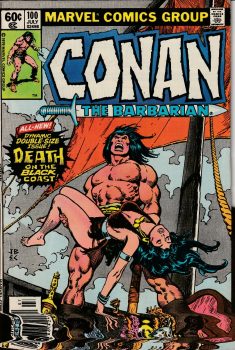 I really enjoyed quite a few of the early issues. #3 was one of my favorite REH historicals, based on “The Grim Grey God. That was immediately followed by the classic “Tower of the Elephant.” #7 was “The God in the Bowl.”
I really enjoyed quite a few of the early issues. #3 was one of my favorite REH historicals, based on “The Grim Grey God. That was immediately followed by the classic “Tower of the Elephant.” #7 was “The God in the Bowl.”
Thomas continued to mix in non-Conan stories, and fragments, by Howard. “Queen of the Black Coast is one of the most popular Conan tales. Thomas built his tenure around this story. Issue #57 was devoted to what resulted in the opening of “Queen,” ending with Conan galloping towards the docks. #48 recounts the first part of Howard’s story, with Conan joining Belit’s crew on the Tigress, and becoming Amra (The lion).
Thomas would get to the second and concluding part, 43 issues later in #100 (in a double-length issue). There were flashbacks, and a few solo adventures, but he had Conan and Belit adventure for about three and-a-half years. Thomas comments that the Miller and Clark timeline (tacitly endorsed by Howard himself) had them roaming for three years.
But there’s plenty of Conan and Belit in this first hundred issues. Belit and Red Sonja (who in Howard’s original stories is nothing like the chainmail bikini clad warrior here) appear in a few issues together. They do not become bffs.
Elric of Melnibone comes by (twice, I think). A John Jakes plot is used, but it’s not one of Brak the Barbarian’s. Thoth Amon emerges as a foe of Conan.
El Borak, Steve Clarney, and Kull, are among those REH characters whose stories are converted to Conan. And many one-off REH stories. Literary estate executor Glenn Lord worked well with Thomas, allowing Marvel to buy the rights to use many REH works (originally Marvel had the character, but not the Conan stories, though that changed).
There’s plenty of original Conan, but it’s cool to see so much Howard – and other writers’, including Norvell Page (separate post coming on that one). I enjoy reading non-Conan stories, such as “Out of the Deep,” rewritten for Conan (that’s a cool Weird Menace story).
I am going to switch over and read some Savage Sword of Conan, having bought the first two Omnibuses. I also skipped over most of the included Annuals, added to the end of each Omnibus. Volume Three had and Annual with the first Conan story, “The Phoenix on the Sword,” which has always been a favorite of mine.
I’ll get back to the final fifteen Thomas stories, which are post-Belit.
But I think that the Conan comic was quite good. If you’re going to check it out, I HIGHLY recommend getting at least Thomas’ first memoir. The books absolutely enhance the experience, issue by issue.
Jeffrey Talanian wrote an essay on Thomas and Conan, which you can read here.
And, this page has ALL of my Robert E. Howard essays here at Black Gate. I’ve written quite a bit.

Bob Byrne’s ‘A (Black) Gat in the Hand’ made its Black Gate debut in 2018 and has returned every summer since.
His ‘The Public Life of Sherlock Holmes’ column ran every Monday morning at Black Gate from March, 2014 through March, 2017. And he irregularly posts on Rex Stout’s gargantuan detective in ‘Nero Wolfe’s Brownstone.’ He is a member of the Praed Street Irregulars, founded www.SolarPons.com (the only website dedicated to the ‘Sherlock Holmes of Praed Street’).
He organized Black Gate’s award-nominated ‘Discovering Robert E. Howard’ series, as well as the award-winning ‘Hither Came Conan’ series. Which is now part of THE Definitive guide to Conan. He also organized 2023’s ‘Talking Tolkien.’
He has contributed stories to The MX Book of New Sherlock Holmes Stories — Parts III, IV, V, VI, XXI, and XXXVII.
He has written introductions for Steeger Books, and appeared in several magazines, including Black Mask, Sherlock Holmes Mystery Magazine, The Strand Magazine, and Sherlock Magazine.
You can definitely ‘experience the Bobness’ at Jason Waltz’s ’24? in 42′ podcast.
Transcendent and Creepy: Rich Horton on The Forever War by Joe Haldeman
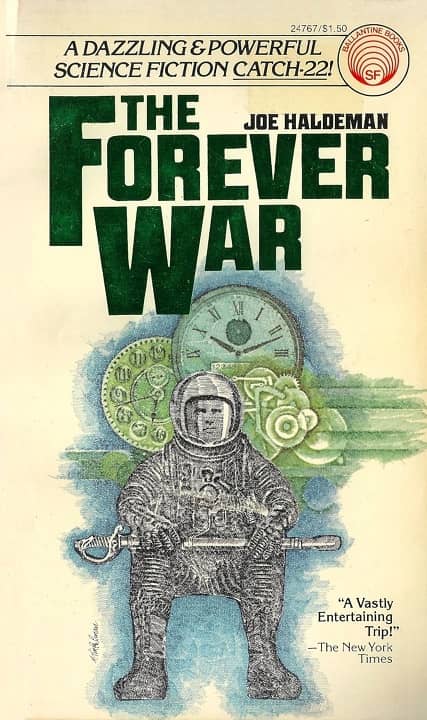
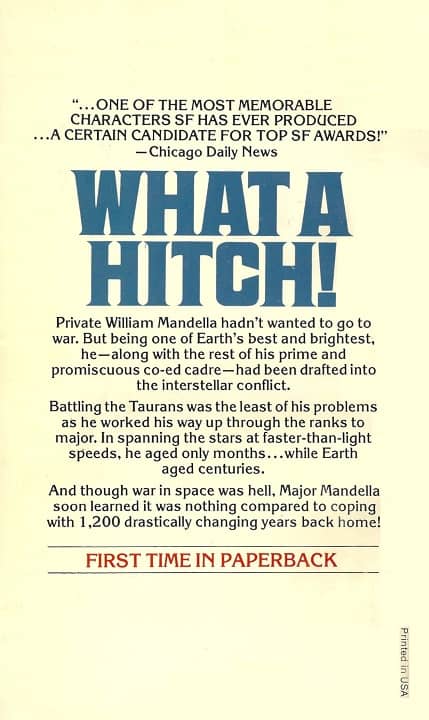
The Forever War (Ballantine Books, 1976). Cover by Murray Tinkelman
Rich Horton continues to review classic science fiction novels at his blog, Strange at Ecbatan. Last month he turned his attention to Joe Haldeman’s The Forever War, on the 50th anniversary of its release.
It’s definitely worth reading — a bitter and cynical look at war, some cool ideas including the effect of time dilation and lots of physics, a somewhat transcendent but pretty creepy conclusion. And, also, some very ’70s things, including pretty questionable — at times downright offensive — “sexual revolution” era sexual politics, and oddly 70s-ish notions of dystopia. My impression… I liked it then and I endorsed its Hugo and Nebula wins.
The Forever War is one of the most honored science fiction novels of all time. First published by St. Martin’s Press in 1975, it swept every major SF Award, including the Hugo, Nebula, and Locus awards. In 1987 it placed 18th on Locus’ list of All-Time Best SF Novels, beating out The Martian Chronicles, Starship Troopers, and Rendezvous with Rama. It’s been in print nearly continuously for the last four and a half decades. Here’s some of the most noteworthy editions.
[Click the images for bigger versions.]
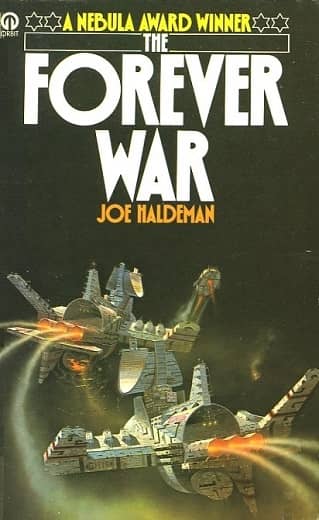

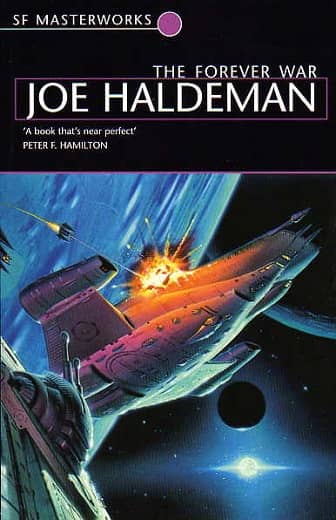
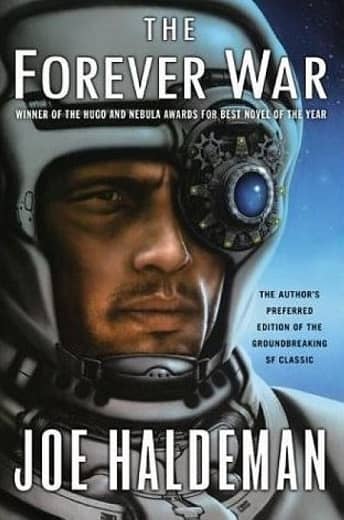
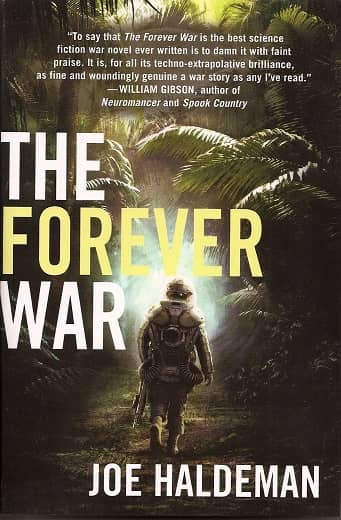
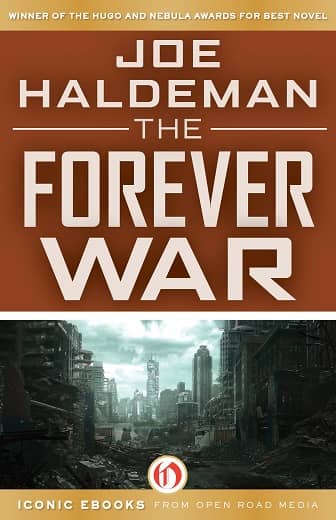
Three decades of The Forever War. First row: Orbit (1976), the first unexpurgated edition (Avon, 1991),
and the Gollancz SF Masterworks edition, with Author Notes (1999). Covers by Patrick Woodroffe,
Dorian Vallejo, and Chris Moore. Second row: Eos (2003), St. Martin’s Griffin (2009), and
Open Road (2014). Covers by Jim Burns, Tomislav Tikulin, and Michel Vrana.
So what’s the book about? Here’s Rich again.
William Mandella is drafted into a war against the aliens, there are several very impressive battle scenes, he falls in love with fellow soldier Marygay Potter, they are separated by time dilation, the war ends when it is realized the whole thing was a mistake due to poor communication, Marygay waits for William by flying back and forth in a spaceship until time dilation means their timelines are synchronized again…
What did I think on a reread? It’s still a pretty effective book. The telling is cynical in a totally believable way. The Army scenes ring very true — and Haldeman would certainly be a better authority than me anyway. The soldiers are foulmouthed, dislike their commanding officers, but fairly disciplined if only because the alternative is dying…
It’s very exciting, and well-written. The battle setups are interesting, and seem like a plausible use of the technology Haldeman invents. Some of this tech is pretty implausible, but in an almost believable fashion. The new section, originally called “You Can Never Go Back”, concerns William and Marygay’s return to Earth after their battles, at which time they are eligible to muster out. They describe at thoroughly decayed Earth society, in a very ’70s fashion. Homosexuality is [encouraged] as a population control measure (though — as Mandella even points out — birth control is pretty easy to enforce anyway.) Haldeman’s depiction of homosexuality is mostly positive, I suppose, but there are some cliches, which I understand he regretted in later years. The rest of the depiction of Earth at that time seems a bit over the top — but partly it’s a device to make it plausible that the two of them reup.
As Rich notes in his review, the early (pre-1991) editions of The Forever War were significantly abridged, omitting the entire middle section. The 1991 edition restored most of the expurgated sections, but left some some clumsy changes from the early edits intact. It wasn’t until 1997 that Avon published a version that Haldeman considered definitive.
See the complete details on the publishing history of The Forever War here at Black Gate, and read Rich’s complete review at his blog here.
You Can’t Handle the Tooth, Part I
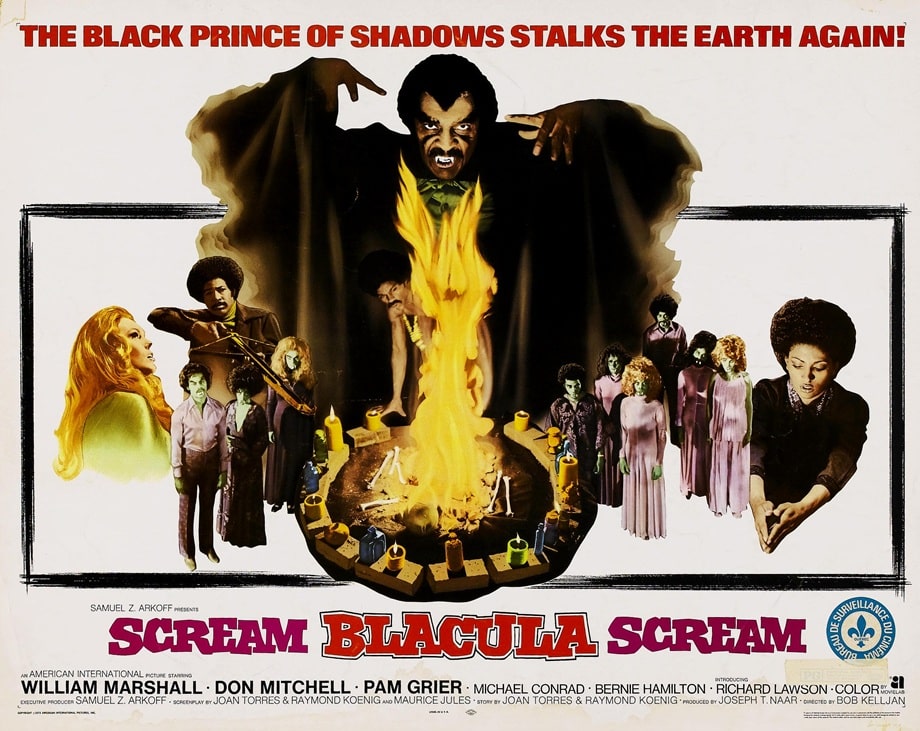 Scream, Blacula, Scream (American International Pictures, June 27, 1973)
Scream, Blacula, Scream (American International Pictures, June 27, 1973)
20 vampire films, all first time watches for me.
Come on — sink ’em in.
Scream, Blacula, Scream (1973) – TubiI’ve seen Blacula (1970) plenty of times, but somehow never got around to watching the sequel, and thank the stars I did, because it’s excellent. I think I like it even more than the original.
If you are new to this nonsense, the original film told the tale of an African prince who is bitten by Dracula and becomes a bloodsucking fiend on the streets of L.A., tapping all jive turkeys he comes across. It’s obviously a product of the Blaxploitation era, but its dodgy premise is saved by the presence of William Marshall. For my money, Marshall can stand toe-to-toe with Christopher Lee as one of my favorite depictions of the count (so to speak). Like Lee, he brings much gravitas, animalistic savagery, and raw sex appeal to the role, along with one of the best voices in the business.
This sequel though has the added bonus of Pam Grier at her height of acting skill and gorgeousness, and a voodoo sub-plot that adds an extra layer to what is ultimately a tragedy. Marshall brilliantly walks the line between monster and victim, and it doesn’t matter how many other players are in the scene, he and Grier keep you mesmerized.
A wonderful start to a new project — onwards and upwards!
8/10
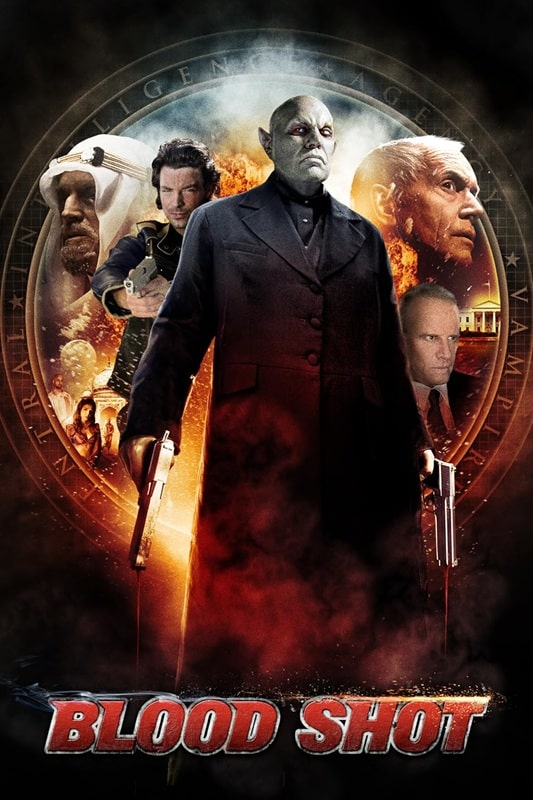

Blood Shot (Infinite Justice Productions, 2013) and Night Teeth (Netflix, October 20, 2021)
Nope, not the quickly forgotten Vin Diesel actioner from four years ago, nor the other Blood Shot from 2013 starring Danny Dyer, this one is a straight to video chunk of sparkly tomfoolery featuring brief cameos from a lot of actors who need new patios.
In a nutshell, the CIA has a special division that employs the services of the last living vampire to take out terrorist threats to the US of A. This vampire (Michael Bailey Smith — wonderful) is a wise-cracking brute of a Nosferatu, and an effective hitman (bitman?). However, his missions are often hampered by a dogged detective, played with maximum grizzledness by Brennan Elliott, who is determined to kill the vamp. His attempts to kill the bloodsucker grow successively funnier as he exhausts his collection of tricks (garlic-filled shotgun shells etc.), all the while getting the snot kicked out of him. Things come to a head when a nefarious gang on a manic jihad arrive in the city, ready to unleash a nuclear bomb, and the vampire and detective must reluctantly team up to take them down.
First of all, I wasn’t expecting anything from this, but I had a splendid time. The snippy buddy-cop routine between the two leads was excellent and there were some genuinely funny moments.
It’s not all YIKES-free though.
A close squint at the poster will reveal Brad Dourif in brown-face and hook-nose prosthetic as ‘Bob’, the jihad organizer whose real name is too long so everyone shortens it. He’s not the only white actor playing a character of Middle-Eastern descent, so be forewarned. It’s a bizarre decision, but perhaps in keeping with the irreverent nature of the story. Also, if you do decide to take a look, don’t be put off by the seizure-inducing first 10 mins. It settles down quickly, possibly because the editor got tired or had to go to hospital.
A cautious recommendation.
7/10
Night Teeth (2021) – NetflixFirst up, I don’t like this title. It’s awkward to say and isn’t very interesting. Secondly, this is a Netflix film, and I like that they are producing so many films and giving newish directors a crack, but I’ve reached the point where they all look the same to me. Same lighting, same editing, same polished ‘product.’
That’s what they’re knocking out. Not films. Content.
Anyhoo, on a more positive note, I liked the idea of L.A. being split into five, vampire-run, districts, and one uppity bloodsucker attempting a coup during the course of one night. The monster on the power trip is Victor (of course), played by Alfie Allen (Theon Greyjoy of GoT), and he has sent his faithful hitwomen out to do the dirty deeds. The bitey ladies, Zoe (Lucy Fry) and Blaire (Debbie Ryan) need a driver for the night, and the hapless Benny (Jorge Lendeborg Jr.) ends up filling in for his brother, who is up to shenanigans. As Benny drives the women from slaying to slaying, he slowly figures out what is going on, and then has to fight for survival.
It’s a potpourri of borrowed ideas from the likes of the Underworld and John Wick films (especially the secret society with rules), and could have been spectacular, but leaden writing and wooden delivery (particularly from Sidney Sweeney and Megan Fox in a 5-minute cameo) let it down. I was really impressed with Ryan and Lendeborg Jr. though, and could stand to see them in more projects.
Recommended if you like glitz and exposition.
6/10


Vampires on Bikini Beach (Beacon Films, 1988) and Dracula:
The Original Living Vampire (The Asylum, January 28, 2022)
Remember the 80s? That glorious time when the best vampire films came out? Fright Night, Near Dark, Lost Boys, Innocent Blood, Vamp, et al. What a time. Anyhoo, writer/producer/director Mark Headley thought “Hey, folks love vampire flicks, and they like bikinis, and my pal needs an 80-minute promo video for his dull band, I got it!” and so this film came to be, and it was bad.
Here’s the skinny: some boring teens find a boring book that has something to do with some boring vampires in the most boring parts of Venice Beach. Boredom ensues.
It’s so shoddily written, acted and filmed, that it can’t even be considered as a ‘so bad it’s good’ flick; it’s just aggressively rubbish. It’s the first hate-watch I’ve done in a while, which is amazing considering all the crap I watch.
Recommended.
1/10
Dracula: The Original Living Vampire (2022) – PrimeCue arguments about whether vampires are technically ‘living.’
Anyhoo, when the words ‘The Asylum presents’ flash up on screen, they tend to trigger a Pavlovian response in that my expectations are immediately quashed. This is a very healthy attitude, and can sometimes lead to a pleasant surprise. Not this time, however.
D:tOLV is a weird film. It really doesn’t know what it wants to be — a horror film, police procedural, or a comedy. I don’t suspect the latter was intentional. It allegedly takes place in the UK, which for some reason is depicted as a turn of the (previous) century Austrian town transplanted to the Carpathians, complete with mountain-top castle. The clothing is early 20th C, houses are lit by candle light and some bulbs, Van Helsing carries a luger, and characters say stuff like ‘it’s above my paygrade.’
Anachronisms aside, it’s an interesting twist on the tale. Amelia Van Helsing is a police detective working with Captain Renfield. Amelia works closely with mortician Dr Seward (Michael Ironside, briefly phoning it in), and chemist Jonathan Harker, as the group tries to solve the murders of a bevy of red-haired women, all drained of blood. When Van Helsing’s girlfriend, Mina, gets targeted by Drac, they must rally forth and get on with some slaying.
This premise is let down by some pretty bland acting (Amelia and Dracula in particular were wrongly cast) and a great deal of dull conversation. I mean, a LOT of conversation. 50% of the film is Harker and Van Helsing pulling a Mulder and Sculley – the twist being that Van Helsing doesn’t believe any of it. The other 50% is filled with Seward talking to himself, some lacklustre action, and a couple of sex scenes to ensure there are some knockers for the foreign markets. Wasted potential.
Minus another point for the bad grammar on the poster.
4/10
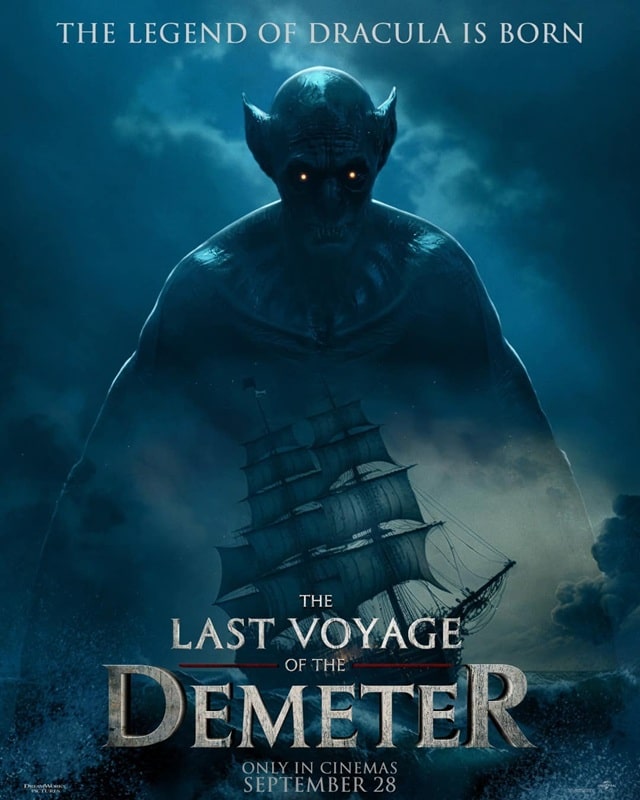
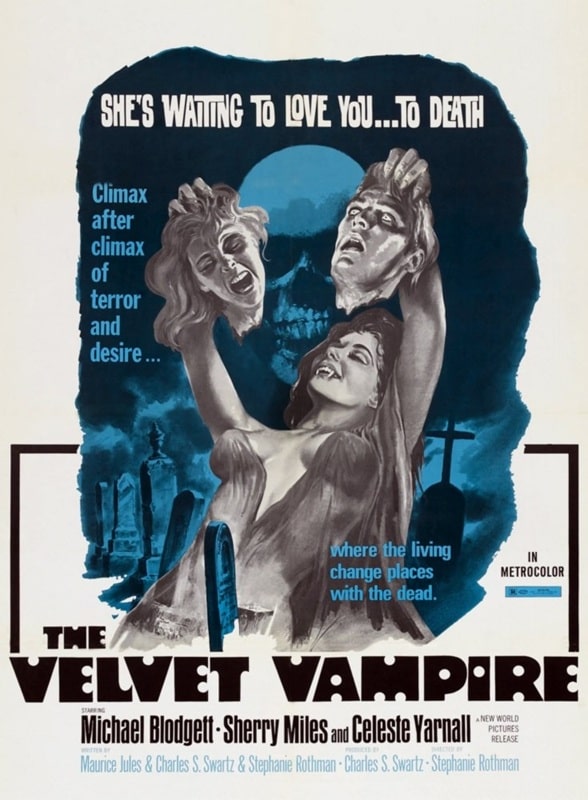
The Last Voyage of the Demeter (Universal Pictures, August 11, 2023)
and The Velvet Vampire (New World Pictures, June 1971)
The untold story of the doomed Demeter from Bram Stoker’s Dracula has long been a gothic tease for horror fans. It has been touched upon in other films (and was my favorite part of the recent Dracula adaptation by Mark Gatiss and Steven Moffat), but my anticipation was riding high when I heard André Øvredal was directing a version of the story. Øvredal is responsible for Troll Hunter and The Autopsy of Jane Doe, two of my favorite films, and with a cast fleshed out by the likes of Liam Cunningham and Corey Hawkins, how could it go wrong? Well, it didn’t, but it also didn’t go spectacularly either.
It looks good, and the performances are great, but there was something about it that didn’t quite work for me. Perhaps it was the repetitive, episodic feel of crewmembers being bumped off one by one while exposed on the deck during the night watch, maybe it was Dracula himself. I loved the design of the vampire, but his face didn’t do it for me. His savagery was undeniable though, and the effects, a seamless blend of practical and CG, were top notch. Hawkins’ character, Clemens, offered up an interesting angle being not only a man of science, but also black, in a time when Eastern Europeans would have been remarkably intolerant. He does touch upon this, but I feel it could have been explored further.
Cunningham is the captain of the ship in every sense of the word, elevating every scene he is in, and the skeleton crew do their jobs well, even if they are largely forgettable aside from the reliable David Dastmalchian. I went into this assuming it would be a ten-out-of-ten movie, but it gets eight from me, partly because I hyped it up too much for myself, and partly because an awesome sequel is hinted at but the box-office was so dire that, like Dracula, it will never see the light of day.
8/10
The Velvet Vampire (1971) – PrimeIt would be remiss of me not to include a title from the Roger Corman stable, so here we are, with a notable title for several reasons. Firstly, it was directed by Stephanie Rothman, a trailblazer in the film industry and responsible for a clutch of genre-bending flicks. Rothman leaned into the fluid sexuality of vampires, no doubt prompted by the recent success of Hammer’s lesbian vampire films (Vampire Lovers, Twins of Evil, Lust for a Vampire), and adapted a story, Carmilla, written in 1872 by J. Sheridan Le Fanu. Carmilla is considered to be the first lesbian vampire story ever published, and the lead antagonist, Diana Le Fanu, is named after him as a direct homage.
The tale concerns Sarah and Lee, a swinging married couple who encounter Le Fanu at an art gallery (where the actual Johnny Shines is playing a fantastic tune), and the enigmatic Le Fanu invites them to stay at her remote home in the middle of the Mojave desert. By this point, Le Fanu has already killed a would-be rapist in the opening scene, so we are well aware of her strength.
Car trouble forces the couple to start walking, but then Le Fanu turns up in a dune buggy (!), and takes them back to her place. After that, not much happens. There’s some walking around, a bit of jealous chat, and some semi-erotic dream sequences, but you will have to wait about 40 mins for someone to actually get bitten.
Naturally, shenanigans ensue.
Is it a great film? Not particularly, but you can see why it’s a cult classic. Lee’s casual promiscuity, Sarah’s blank-faced screaming, Diane’s bisexual seductions, some early electronic scoring, and some lovely color design (look for all the red bits) are certainly worth a look if you don’t have anything more pressing to attend to.
5/10
Previous Murky Movie surveys from Neil Baker include:
You Can’t Handle the Tooth, Part II
Tubi Dive
What Possessed You?
Fan of the Cave Bear
There, Wolves
What a Croc
Prehistrionics
Jumping the Shark
Alien Overlords
Biggus Footus
I Like Big Bugs and I Cannot Lie
The Weird, Weird West
Warrior Women Watch-a-thon
Neil Baker’s last article for us was Part VII of Tubi Dive. Neil spends his days watching dodgy movies, most of them terrible, in the hope that you might be inspired to watch them too. He is often asked why he doesn’t watch ‘proper’ films, and he honestly doesn’t have a good answer. He is an author, illustrator, teacher, and sculptor of turtle exhibits. (AprilMoonBooks.com).
Immerse Yourself in 12 Influential Short Story Novels That Epitomize the Form
Are you ready to read a collection of short stories that reads like a novel?…
The post Immerse Yourself in 12 Influential Short Story Novels That Epitomize the Form appeared first on LitStack.
THE FRUGAL WIZARD’S HANDBOOK FOR SURVIVING MEDIEVAL ENGLAND by Brandon Sanderson
Tor Doubles #8: Leigh Brackett’s The Nemesis from Terra and Edmond Hamilton’s Battle for the Stars
 Cover for The Nemesis from Terra by Tony Roberts
Cover for The Nemesis from Terra by Tony RobertsCover for Battle for the Stars by Bryn Barnard
This volume includes the story Nemesis from Terra by Leigh Brackett and Battle for the Stars, byt Edmond Hamilton. There are two significant distinctions for this volumes. The two authors represented were married to each other and one of the stories was previously included in the Ace Double series. The Tor Double was originally published in May 1989.
The Nemesis from Terra was originally published as “Shadow Over Mars” in Startling Stories in Fall, 1944. It was previously published as part of an Ace Double (F-123, with Robert Silverberg’s Collision Course) in 1961. The Nemesis from Terra is the first of three Brackett stories to be published in the Tor Doubles series.
Although set on Mars in the far future, as with many of Brackett’s Martian stories, The Nemesis from Terra feels more like a fantasy novel than a science fiction novel. It is a descendant of the Mars of Edgar Rice Burroughs and could easily be classified with the stories of Robert E. Howard, neither of which is a surprise.
Rick Urquhart is the main character of the novella, although to call him a protagonist gives him more agency than he really has. From the earliest pages, in which he ducks into a doorway to avoid the anthropoid Martians who are tracking him down and hears an old woman prophecy that his shadow will extend over Mars until the final pages, he is more reactive to events, whether they are forcing him into a course of action or he is attempting to avenge wrongs perpetrated on him.
His life isn’t entirely horrible. While escaping the clutches of the evil Terran Exploitation Company, run by Ed Fallon and his henchman Jaffa Storm, Rick meets Mayo McCall, and the two fall instantly in love, although there seems little reason for their affection. Rick is also the subject of Kyra’s love, a young winged Martian girl, who sees in him the future of Mars.
Of more interest that the plot or Rick himself, is Brackett’s complex depiction of her Martian society. Made up of humans and Martians, the humans, like Fallon, are looking to exploit the planet. There seem to be multiple races of sentient Martians who are not unified. The Martians led by Haral, the last of his line, possess the Collar of Ruh, which signifies legitimacy to rule. The Thinkers are a legendary race of Martians who may have plotted out the planet’s history before disappearing. The winged race to which Kyra belongs lives in their own city, mostly not venturing forth.
Brackett briefly explores all of these civilizations, as well as Fallon’s Company, his competitor, Hugh St. John, and briefly mentions regulatory agencies which deal with Martian and interplanetary trade. The result is a complex society, but one which Brackett is not able to fully explore and Rick is buffeted by all of their forces to fulfill the old woman’s prophecy.
Although the prophecy regarding Rick is uttered in a small, secluded room, the contents of the prophecy become generally known without agency. Although Rick initially fights against the idea that he will one day rule Mars, a concept which puts a target on his back for all of the various entities Brackett has created. However, Despite the love that Mayo and Kyra seem to feel for him, Rick’s self-centeredness makes him hardly a sympathetic figure for the reader. Not evil, especially when compared to Fallon and Storm, Rick doesn’t seem to believe in anything and never really changes. His motives are almost entirely self-preservation and vengeance. Even Mayo, who purportedly loves him questions whether the prophecy is right about him and whether she wants to see him succeed. The only complete affection for Rick that is shown is by Kyra, who Rick seems to see more as a tool to be used than as a person.
Brackett’s complex Martian society demonstrates that even at this early stage of her career, this was her first novel, although she had been publishing short stories for eleven years, shows her strengths. While characterization is a weakness in The Nemesis from Terra, that is also an area in which Brackett would eventually improve.
Although Brackett and Hamilton first met in 1940, they didn’t marry until 1946 and remained together until his death in 1977. Brackett survived her husband by thirteen months, during which time she worked on the first draft of a sequel to Star Wars, which was ultimately not used, although she received a writing credit on the film The Empire Strikes Back.
 Startling Stories Fall 1944 cover by Earle K Bergey
Startling Stories Fall 1944 cover by Earle K BergeyBattle for the Stars cover artist unknown
Battle for the Stars was originally published as a stand-alone novel by Dodd, Mead in November, 1961. Edmond Hamilton began publishing in 1926, and although his earliest stories appeared in Weird Tales and were Lovecraftian and Howardian in their feel, he eventually turned his attention to science fiction, writing the 1940s Captain Future stories. And eventually for DC Comics. He gained the nickname “World Wrecker” for the wake of destruction that occurred throughout his stories.
Given that reputation and the title Battle for the Stars, it would seem clear that this novel, which was originally published in 1961, would not only include the promised battle of the title, but also the destruction of worlds, although as it happens, Hamilton shies away from that trope in this novel.
Commander Jay Birrel leads the Fifth Squadron and reports to Ferdias, the leader of Lyra Sector, one of many galactic sectors that is jostling for supremacy in a galaxy in which Earth has fallen to a backwater planet. Lyra sector’s main rival is the Orion Sector, and the novel opens the one the Orion’s agents, Taucer, attempting to torture Birrel, who manages to escape.
Birrel is ordered to lead the Fifth Squadron to Earth, not to invade the planet, but to serve as an emissary from Lyra on the occasion of the bicentennial of the first spaceflight. Ferdias is aware that there are rumors that he is trying to conquer the Earth, and in addition to assuring Birrel that it isn’t the case, he tells Birrel that the Fifth Squadron will be accompanied by a variety of other ships that includes the civilian dependents of the soldiers of the Fifth Squadron.
To make things more interesting, Birrel is married to Lyllin, a Lyran woman who has no desire to leave her native planet, but understands that Birrel’s duty can splash onto her. She is more concerned about the fact that three of Birrel’s ancestors are from Earth, giving him closer ties to the planet than most, and she worries about the planet’s pull on him and whether they will ultimately be able to return to Lyra or if he will chose to remain on Earth, a notion Birrel finds ridiculous since he has never visited the planet and has no real desire to.
Birrel and Lyllin’s relationship is one of the weaker points of the novel. The two characters don’t really seem to know each other or even talk to each other. If Lyllin makes her concerns known, Birrel pushes them aside. He orders her around as if she were serving on one of his ships without noticing that she is his wife and doesn’t feel she should have to follow his order.
However, Hamilton’s strength shows through in his treatment of the political situation. When ordered to Earth, Birrel reminds Ferdias that he is not a diplomat, but his dealings with the Terrans Charteris and Mallinson help move the Lyran agenda along. At the same time, Despite Birrel knowing that the Lyrans are on Earth merely to help celebrate the bicentennial of spaceflight, the reader is constantly wondering if Charteris and Mallinson are correct that the Lyrans desire to conquer the Earth. Ferdias clearly hasn’t told Birrel everything and the reader can only surmise the plans that have not been revealed to him.
Part of Birrel’s orders involve him visiting the small town of Orville, New York, where his great-grandfather lived. Although his connection in Orville doesn’t go as intended, Hamilton creates a welcoming small town that remembers when Birrel’s ancestors lived there and welcome him as one of his own, despite his protestations. These sections display a nostalgia that is not typically associated with Hamilton’s writing and Orville almost feels like the sort of rural community Clifford D. Simak wrote about.
Ultimately, the Terrans must decide whether they distrust the Lyrans or the Orionids more, for if the Orionids attack, as Birrel believes that will, they will need Lyran help to fend them off, but the rumors swirling are that any attack on each will come from the Lyrans. The fact that Birrel is raising the alert level of the Fifth Squadron in response to his believes about the Orionids only causes the Terrans to take actions that make him continue to raise the alert level, making the Terrans that much more sure of his intentions.
The political situation facing Birrel and the Terrans is complex, but at the same time, it seems overly simplistic. Hamilton has created a system in which, although his focus is on the Lyrans, Terrans, and Orionids, there are several other sectors that come into play. On a more micro level, once Birrel arrives in Orville, the very friendliness of the locals raises questions of paranoia. Which of them are in the employ of the Orionids or the Terrans. Which of them hold a grudge against Birrel for something done by his ancestors. The personal aspects of Orville adds an entire unexpected facet to the story.
The cover for The Nemesis from Terra was painted by Tony Roberts. The cover for Battle for the Stars was painted by Bryn Barnard.
 Steven H Silver is a twenty-one-time Hugo Award nominee and was the publisher of the Hugo-nominated fanzine Argentus as well as the editor and publisher of ISFiC Press for eight years. He has also edited books for DAW, NESFA Press, and ZNB. His most recent anthology is Alternate Peace and his novel After Hastings was published in 2020. Steven has chaired the first Midwest Construction, Windycon three times, and the SFWA Nebula Conference numerous times. He was programming chair for Chicon 2000 and Vice Chair of Chicon 7.
Steven H Silver is a twenty-one-time Hugo Award nominee and was the publisher of the Hugo-nominated fanzine Argentus as well as the editor and publisher of ISFiC Press for eight years. He has also edited books for DAW, NESFA Press, and ZNB. His most recent anthology is Alternate Peace and his novel After Hastings was published in 2020. Steven has chaired the first Midwest Construction, Windycon three times, and the SFWA Nebula Conference numerous times. He was programming chair for Chicon 2000 and Vice Chair of Chicon 7.
Review: The Price of Power by Michael Michel (by Adam Weller)

Book links: Amazon | Goodreads
About the book: Prince Barodane could not hold back the darkness. Not even in himself. He laid an innocent city in its grave and then died a hero.
In his absence, war whispers across the land.
Power-hungry highborn dispatch spies and assassins to the shadows as they maneuver for the throne, while an even greater threat rises in the South. Monsters and cultists flock to the banners of a mad prophet determined to control reality…and then shatter it.
Destiny stalks three to the brink of oblivion.
A dead prince who isn’t dead. Barodane buried his shameful past in a stupor of drugs, drink, and crime. Now, he’d rather watch the world fall apart than wear the crown again.
An orphan with hero’s blood who's forced to make a harrowing betray her country or sacrifice her first love.
And a powerful seer who has no choice at all–her grandson must die.
If any of them fails to pay the price…
The cost will be the world’s complete annihilation.
Formats: Audiobook, ebook, paperback
REVIEW: The Price of Power is an impressive start to an intricately plotted dark fantasy saga. Michel’s writing shines with his fine attention to detail, a polished prose, and a rich, moral ambiguity where you’re never comfortable rooting for a particular side.
Two empires have been struggling for decades. One side invaded and enslaved the other, but the slaves broke free and overcame their oppressors while unifying disparate territories into a sovereign nation. But as time passed, the oppressed became the oppressors; they enacted a horrifying tradition of permanently scarring the newborns of their old enemies. There are legitimate arguments on both sides for generational hatred, and the current balance of peace vs. rebellion is teetering on the precipice of disaster.
We follow several POVs across the continent: a powerful Grandmother tasked with training a doomed young boy; an isolated princess forced to prove her worth to save the kingdom from shattering into chaos; a disgraced war veteran-turned-drug dealer haunted by madness and regret; an ally of the veteran who traded honor for loyalty; a defeated and abused pig farmer who embarks on a suicide march up a cursed mountain haunted by demons and untold power.
The vast majority of the story has very little crossover between the characters, but the threads start to weave together near the conclusion. While there was some predictably with some of the later reveals, Michel’s strong character development and emotional growth elevated the reading experience.
The pacing was also strong, as I longed to return to each POV to see what would happen next — but was never upset about switching over to the next chapter POV. There was a good balance between action, plot development, and the emotional struggles each character was facing.
This is not a short book, but it still felt like it was all about setup — characters were introduced, stakes were raised, and pieces put in place for a long, complex, and exciting journey ahead.
I wouldn’t classify this as grimdark although it’s easy to see how others might. Just be warned that this is not an uplifting book — many terrible things happen to good people, and justice is fleeting. But for those who like grit and grime and no easy solutions, this is an easy recommendation to make. I already started the prequel novella and eagerly await book two’s release.



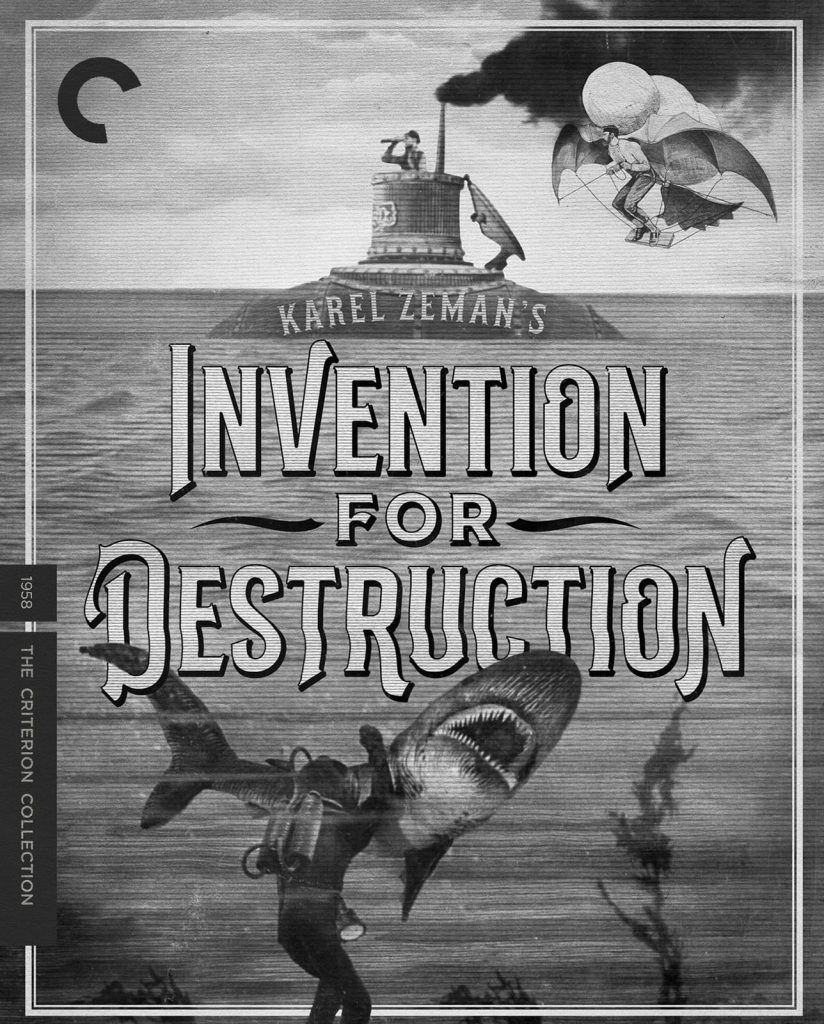
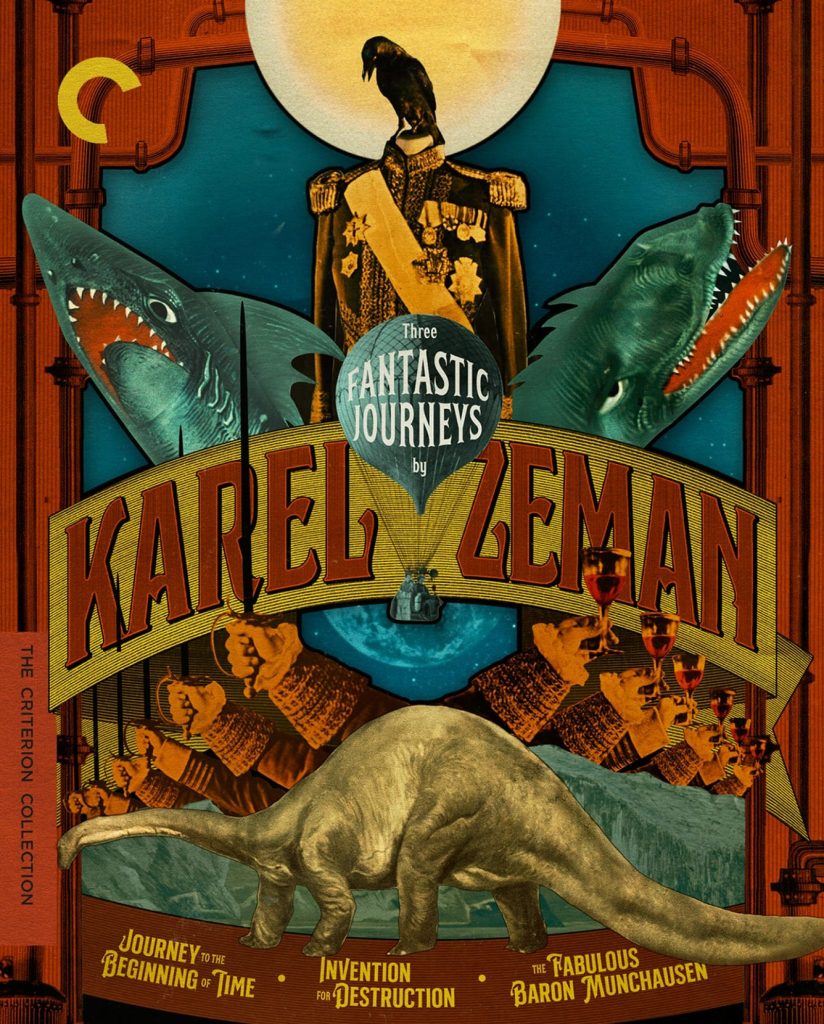
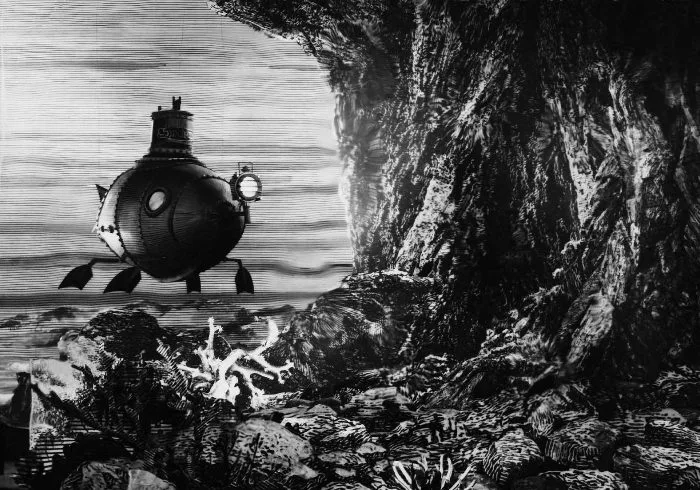
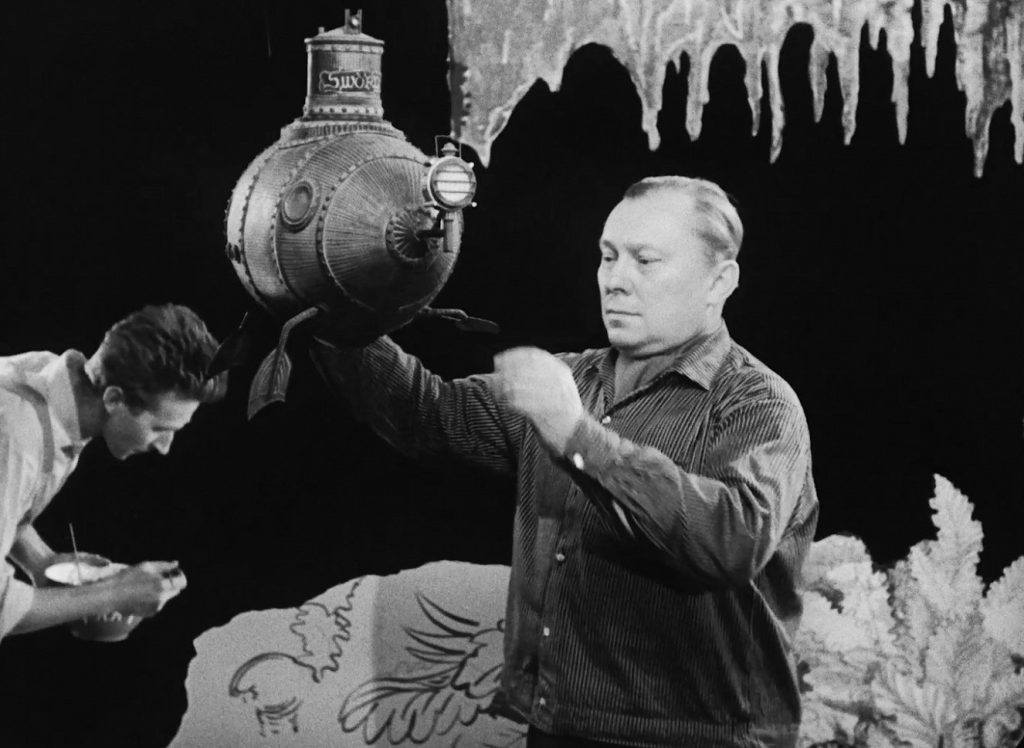
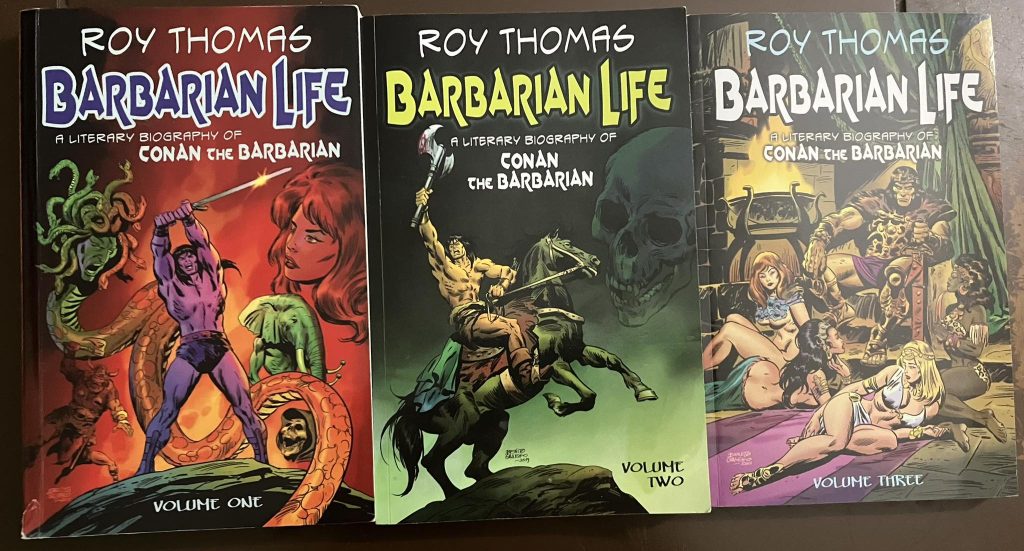
Recent comments